Star Trek: Deep Space Nine
- View history
Star Trek: Deep Space Nine was the fourth Star Trek series and entered production in 1992 . It was broadcast in first-run syndication from January 1993 until June 1999 .
It was the first Star Trek series created by Rick Berman and Michael Piller rather than by Gene Roddenberry . It was also the only series to air alongside another Star Trek production throughout its entire run, airing alongside Star Trek: The Next Generation from 1993 until 1994 , and then with Star Trek: Voyager from 1995 until 1999 .
- Main Title Theme (seasons 1-3) file info
- (Themes composed by Dennis McCarthy ).
- 1.1 The characters
- 1.2 Alien races
- 1.3 The mirror universe
- 1.4 Technology
- 1.5 Costumes
- 2.1 Development
- 2.2 Serialization
- 3.1 Starring
- 3.2 Also starring
- 3.3 Special guest stars
- 3.4 Special appearances by
- 3.5 Recurring characters
- 4 Executive producers
- 5 Staff writers
- 6.1 Season 1
- 6.2 Season 2
- 6.3 Season 3
- 6.4 Season 4
- 6.5 Season 5
- 6.6 Season 6
- 6.7 Season 7
- 7 Related topics
- 9 External links

Summary [ ]
Deep Space Nine goes where no Star Trek series had gone before – DS9 was the first Star Trek production not based on a starship , but instead, a starbase , known as Deep Space 9 (the starship USS Defiant was introduced in season 3, but the station remained the primary setting of the series). The show is known for its complex characters and storylines, engaging battle scenes and darker (less Utopian) atmosphere. Unlike its predecessors Star Trek: The Original Series and Star Trek: The Next Generation , Deep Space Nine tended to avoid an episodic format for most of its run and instead featured multiple-episode story arcs .
The show broke the "standard format" for Star Trek shows a number of times as well, with a direct, first-person narrative providing the commentary for the episode " In the Pale Moonlight ", a retelling of a classic TOS episode from a different angle in " Trials and Tribble-ations ", life in the racially segregated 1950s in " Far Beyond the Stars ", and a reintroduction of the concept of "black ops" to the Star Trek universe with Section 31 : " Inquisition ". The show also broke with tradition – and with the two Star Trek series that followed it – by featuring a commanding officer as the star of the show at the rank of commander, rather than captain, for a significant portion of its run, until Sisko was eventually promoted to captain in " The Adversary ". Additionally, a number of the episodes and main storylines focused entirely on characters who weren't members of Starfleet: for example, those revolving around Kira, Odo, Jake Sisko, and Quark. (" Progress ", " Shakaar ", " The House of Quark ", " Heart of Stone ", " Prophet Motive ", " Little Green Men ", " Bar Association ", " Body Parts ", " Nor the Battle to the Strong ", " The Ascent ", " The Darkness and the Light ", " Business as Usual ", " Ties of Blood and Water ", " Ferengi Love Songs ")
The characters [ ]
Unlike other Star Trek series, DS9 also had a large cast of recurring characters . Such characters included Nog , Rom , Elim Garak , Dukat , Vedek Bareil Antos , Winn Adami , Weyoun , the Female Changeling , Damar , Martok , Kasidy Yates , Leeta , Brunt , Ishka , and Zek .
Miles O'Brien , and later Worf , were two characters imported from TNG. Worf – a major character from TNG – played a large role on DS9. Several Next Generation characters also had recurring roles on the show, such as Keiko O'Brien and Gowron . Several other TNG characters made appearances too, such as Captain Jean-Luc Picard , Thomas Riker , Q , Lwaxana Troi , Kurn , Lursa , B'Etor , Admiral Alynna Nechayev , Vash , Toral and Alexander Rozhenko . In addition, Julian Bashir and Quark also had one-time appearances on The Next Generation , in " Birthright, Part I " and " Firstborn " respectively. Quark (and the station itself) also made a cameo in the pilot of Star Trek: Voyager , " Caretaker ". Characters from The Original Series were also re-introduced in DS9, including Kor , Kang , Koloth , and Arne Darvin .
The series also featured a number of episodes in which the character of Miles O'Brien was subjected to particular trauma. This became an in-joke among the DS9 writing staff, who called them "O'Brien Must Suffer" episodes and went to great lengths to produce at least one such episode per season. ( Star Trek: Deep Space Nine Companion (p. ? ))
Alien races [ ]
The series focused on several races that were first featured on TNG, such as the Bajorans , the Cardassians , the Trill , and the Ferengi . Later, the Klingons and the Romulans (both created in TOS) became pivotal species in the series. Many other species made appearances on the series, including Vulcans , Bolians , and Benzites . The series also created many species of its own, most notably the Changelings , the Vorta , and the Jem'Hadar , who formed part of the Dominion .
Jadzia Dax and other Trills portrayed in DS9 were distinctly different from how Trills had been depicted in the TNG episode " The Host ". In DS9, the relationship between host and symbiont was described more as a truly symbiotic relationship rather than the symbiont dominating the host. Trills now having spots, rather than prosthetic make-up, was due to studio executives feeling that Jadzia Dax actress Terry Farrell was too attractive to cover her face up. ( Cinefantastique , Vol. 23, No. 6, p. 21)
Another significant change was the relationship Ferengi had with Humans . The Ferengi on TNG had originally been intended to be a new adversary comparable to the Klingons in TOS, although the writers had quickly realized how ridiculous the Ferengi were as villains. In DS9, the Ferengi were mainly entrepreneurs and the Ferengi Alliance was a politically neutral economic power.
Deep Space Nine also featured several regular characters who were not members of Starfleet , with Kira Nerys , a member of the Bajoran Militia , and Odo , the station's chief of security , as well as civilians such as Quark and Jake Sisko .
The mirror universe [ ]
The series spent some time exploring the mirror universe , which had not been seen since the TOS episode " Mirror, Mirror ". The mirror universe was featured in five episodes of the series: " Crossover ", " Through the Looking Glass ", " Shattered Mirror ", " Resurrection ", and " The Emperor's New Cloak ".
Technology [ ]
The show also focused on a wider array of uses and depictions of functions for holographic simulations (known as a holodeck in TOS and TNG but as a holosuite in DS9). In addition to many obvious activities (such as those referenced by Chief O'Brien and Julian Bashir) which were completely in keeping with holodeck usage on The Next Generation , the numerous applications of the holosuites on DS9 included them being used as: a recurring background for people to hang out in, in the form of a 1960s Las Vegas lounge (in numerous episodes); a weapons showroom (by Quark); and the location for a baseball game between teams assembled by Sisko versus Solok , a long-time rival Vulcan captain (in " Take Me Out to the Holosuite ").
Costumes [ ]
DS9 initially featured a noticeable change in Starfleet uniform to a reversed color scheme of the TNG uniform, which is a black design with the division color on the shoulders and a grayish-indigo undershirt underneath the uniform, resembling the cadet uniforms seen on The Next Generation . This design is called the old DS9-style uniforms . It was mostly implemented as a continuation of Star Trek 's pattern of changing uniforms over time, although factors such as the discomfort of wearing TNG-style uniforms played a role as well.
What came to be known as the DS9-style uniforms were more of a variant than a switch, however, due to the cost of producing all-new uniforms. This is why, for example, the DS9 crew themselves wear old DS9-style uniforms from the beginning of DS9 pilot episode " Emissary " up to the fifth season episode " The Ascent ", and this style was also later used throughout Star Trek: Voyager . Meanwhile, even after TNG had gone off the air, the dress uniforms and flag officer uniforms on DS9 up until the sixth season (as well as uniforms on Earth , as seen in the fourth season episodes " Homefront " and " Paradise Lost ") were " TNG-style ".
These discrepancies were corrected with the later switch to a unified, "gray-on-black" format with the division color undershirts (known as the “ DS9-style ”), which was used through Star Trek Nemesis and were also used in this series, starting with " Rapture " and for the remainder of this series, though the old DS9-style uniforms in this series appeared four more times following the uniform change in the episodes, " In Purgatory's Shadow " and " By Inferno's Light " as well as seen on a photograph of " Field of Fire " and in the flashback scenes of " What You Leave Behind ".
Background information [ ]
Development [ ].
The decision to set the series on a space station, rather than a starship, spawned when Brandon Tartikoff originally approached Rick Berman about the show, in 1991, and specifically said he wanted it to have a format that was new for Star Trek but was classically western; if The Next Generation was Wagon Train in space, Deep Space Nine was to be The Rifleman in space – a man and his son coming to a dilapidated frontier town on the edge of known civilization. Berman brought this concept to Michael Piller , and together they set about creating a western in space. As Robert Hewitt Wolfe later explained, " We had the country doctor , and we had the barkeeper , and we had the sheriff and we had the mayor , we had it all, it was all there. We had the common man, Miles O'Brien , the Native American, Kira . " Indeed, the producers initially discussed setting the show at a colony on an alien planet rather than on a space station. This idea was ultimately rejected because it was felt that it would involve too much location shooting, and because they felt that fans of Star Trek wanted to see story lines set primarily in space , not on a planet. ( New Frontiers: The Story of Deep Space Nine , DS9 Season 2 DVD special features)
The change of venue to a space station was largely intended to differentiate DS9 from The Next Generation , because the producers felt that having two shows about a starship airing simultaneously would be unacceptable. As co-creator and executive producer Rick Berman later explained, " Because there were two years of overlap with The Next Generation , we could not create a show that took place on a spaceship. It just seemed ridiculous to have two shows and two casts of characters that were off going where no man has gone before. It was a land-based show, it was a show that in a sense was taking place on a space station. So it had to be an entirely different concept. " ( Deep Space Nine: A Bold Beginning , DS9 Season 1 DVD special features)
The decision to set the show on a fixed station rather than a traveling starship was also based upon a desire to look deeper into the actual workings of the Federation and to see how it dealt with the type of problems one wouldn't find in a show set upon a starship. Michael Piller felt that, by having the characters standing still, they would be forced to confront issues not usually applicable to people on a starship. Whereas on The Next Generation , issues raised each week could simply be forgotten about the following week as the ship visited somewhere else, on a space station, events couldn't be forgotten or left behind but instead had to have implications for the future. As Piller explained, " We didn't want to have another series of shows about space travel. We felt that there was an opportunity to really look deeper, more closely at the working of the Federation and the Star Trek universe by standing still. And by putting people on a space station where they would be forced to confront the kind of issues that people in space ships are not forced to confront. In a series that focuses on a starship, like the Enterprise , you live week by week. You never have to stay and deal with the issues that you've raised. But by focusing on a space station, you create a show about commitment. It's like the difference between a one-night stand and a marriage. On Deep Space Nine , whatever you decide has consequences the following week. So it's about taking responsibility for your decisions, the consequences of your acts. " ( Star Trek: Deep Space Nine Companion (p. ? )) Similarly, in 2002 , Piller stated, " If you look at The Next Generation , it's really about movement. You don't ever stay in one place long enough to get to know anybody. Well Deep Space Nine is a show where everybody is forced to stay week after week, so each episode, each show, is fundamentally dealing with the people who have to learn that actions have consequences, and they have to live with the consequences of their actions on a weekly basis. " ( New Frontiers: The Story of Deep Space Nine , DS9 Season 2 DVD special features)
Setting the show in a fixed location meant that a large cast of recurring characters could be built up with relative ease; much more so than in The Original Series or The Next Generation before it, or Star Trek: Voyager , Star Trek: Enterprise , or Star Trek: Discovery since. As Rick Berman, speaking in 2002, stated, " The show was land-based, but the benefit we got from that was that by staying in one place, it enabled us to create twenty or thirty secondary and recurring characters, which really enriched the show because of all the multi-layers of relationships that have existed over the years. It's a very character-driven show as a result, and I think that makes it quite unique. " ( Deep Space Nine: A Bold Beginning , DS9 Season 1 DVD special features)
The decision to set the show in a fixed location was regarded as a benefit by the series' staff writers. For example, Ira Steven Behr , speaking in 1996 , commented, " We have certain advantages that I think no other Star Trek series has had, because we do have a base of operations that doesn't travel through space, which is the space station. Every story we do, the repercussions, the consequences don't disappear. It's not like the other shows where you have an adventure and then you zoom off into the great unknown. We are here, we have made a home, what we do has consequences. And I think we're able to do this mosaic, this fabric of life in the future, which I like. " Similarly, Robert Hewitt Wolfe, speaking in 2002, stated, " I think if Next Generation and The Original Series were about going out there and discovering new things about other races, Deep Space Nine is about staying in one place and discovering new things about ourselves. Not that we didn't go out there and discover things, but we had the same characters, we didn't change location every week. Sisko couldn't just solve a problem and sail off into the sunset, and never have to go back to that place again. That place was always there, and that problem could always come back to haunt him. So, in a lot of ways, it was a more complex show. " ( New Frontiers: The Story of Deep Space Nine , DS9 Season 2 DVD special features)
The series was designed to have more interpersonal conflict than its predecessors, while still staying true to the universe that Gene Roddenberry had created. Rick Berman commented, " [Deep Space 9]'s an alien space station that doesn't work the way they want it to, and that in itself created a lot of conflict. At the same, our core characters are Starfleet officers; Sisko, O'Brien, the doctor and Dax in no way vary from The Next Generation in terms of the lack of conflict among themselves. That was a rule we had to follow. " ( Captains' Logs Supplemental - The Unauthorized Guide to the New Trek Voyages , p. 5) Berman also commented, " What we wanted to do was something that was almost paradoxical – bring conflict but not break Gene's rules. They still play paramount importance in what we're doing. We created an environment where Starfleet officers were in a location that they weren't happy about being in, and they were in a location where the people who lived there weren't all that happy about them being there. " ( Captains' Logs Supplemental - The Unauthorized Guide to the New Trek Voyages , p. 8)
The show's main cast was intentionally assembled to create conflict (Quark and Odo, Kira and Sisko, etc.), so as to contrast the relatively tranquil atmosphere aboard Federation starships. This was another very specific decision taken by the producers. Gene Roddenberry's golden rule was that there was to be no conflict among Starfleet characters, so the producers decided to introduce non-Starfleet characters so conflict could come from within the show rather than always coming from outside (as it did on TNG). Rick Berman recalled, " We [....] created a situation where we had people who were members of our core group who were not Starfleet: the security shapeshifter Odo; the Bajoran Major, Kira; the bartender, Quark. A group of our integral people are not Starfleet officers, and the ones that are Starfleet officers aren't crazy about where they are, so we have a lot of frustration and conflict. " ( Captains' Logs Supplemental - The Unauthorized Guide to the New Trek Voyages , p. 8) Writer Joe Menosky explained, " You can see right away they're not the perfectly engineered Humans of TNG. They seem more real. I don't know if that makes them as attractive to viewers or not. But they are really different, and they represent a different way to tell a story. And it was definitely a conscious choice to create that potential for conflict. " Similarly, Berman stated, " Viewers didn't see that group of loving family members that existed on the first two Star Trek shows. " ( Star Trek: Deep Space Nine Companion (p. ? )) Michael Piller also commented on this somewhat controversial aspect of the show; " One of the primary goals of the development process was to come up with a show that had more inherent conflict than The Next Generation . In order to do that, you have to understand that Gene Roddenberry had a very specific vision for humanity in the 24th century. What that meant for The Next Generation was that everybody gets along remarkably well on the Enterprise . There's very little room for interpersonal conflict between those people. In this series, we set out to create a situation that would provide natural conflict. We've populated the show with several aliens, primarily Bajorans , as we are stationed on the edge of the Bajoran star system . And the Bajorans are very different people than we are. They are people who are very spiritual and mystical and have a whole different way of looking at life than the 24th century humanist views which many of our Starfleet people will have. So immediately, there are conflicts. And then there's additional aliens from elsewhere who are thrown into the mix. So, as regular characters, not all the people are Starfleet, not all the people are Human, and as a result, you have this continuing conflict, because people who come from different places, honorable, noble people, will naturally have conflicts. " ( Deep Space Nine: A Bold Beginning , DS9 Season 1 DVD special features)
Unlike with TOS and TNG, Gene Roddenberry wasn't directly involved in conceptualizing DS9. Regarding Roddenberry's involvement in the series, Rick Berman stated, " Michael and I discussed it with Gene when we were still in the early stages, but never anything conceptual. " " We never got a chance to discuss it (the concept) with Gene. By the time we had it to the point that it was discussable, he was in pretty bad shape and not really in the condition that it would have been wise to discuss it with him. On two specific occasions I was with him at his house and we tried to bring it up, but it wasn't really appropriate. " ( Captains' Logs: The Unauthorized Complete Trek Voyages , p. 328) Director Paul Lynch remarked, " My gut feeling is that Gene would be jumping up and down. This is definitely a different take on what Gene spawned, but I think he would love it [....] While it's quite different, Deep Space Nine is also, in many ways, quite the same. All of Gene's moral requirements are upheld in this show. If we've done anything, we've expanded on what Gene created. " ( The Official Star Trek: Deep Space Nine Magazine issue 1 , pp. 10 & 12)
Initially, Berman and Piller were at a loss for a title for the series and toyed with calling the series "The Final Frontier". During further development, the station was temporarily dubbed "Deep Space Nine", which not only stuck permanently as the name of the station, but also the title of the show itself. Despite this, the two co-creators were reportedly dissatisfied with the name. ( Trek: Deep Space Nine: The Unauthorized Story , pp. 17-18)
Miles O'Brien was brought aboard DS9 and made a part of the space station's senior staff because the producers felt that Colm Meaney was too talented an actor to confine his character to a transporter room . Additionally, they hoped the TNG crossover would help boost the new series' ratings.
In the Star Trek: Deep Space Nine Companion (p. ? ), Michael Piller explained the rationale behind each of the principal cast members, why each character was chosen, and what each one was to bring to the mix;
- Jadzia Dax: " The Trill is a great race. They had some interesting ramifications on TNG. A Trill character would provide great potential for dichotomy and paradox. "
- Odo: " We knew that we needed some kind of Data / Spock character who looks at the world from the outside in. And the idea that an alien entity would have to find some way to pass as Human was fascinating, and seemed to give us an avenue into the kind of 'complexion of humanity' stories that we wanted to tell. "
- Quark: " A Ferengi would provide the show with instant humor and built-in conflict. I saw Quark as the bartender who is a constant thorn in the side of law and order, but who has a sense of humor about it. He'd be someone who could obviously throw lots of story dynamics into play. "
- Julian Bashir: " We decided to create a flawed character. He'd have to be brought down to size in order to grow. And we wrote him as kind of a jerk for much of the first season . "
- Miles O'Brien: " After we decided we were bringing him over to the new show, we thought, 'How do we use him?' We'd already decided to focus on Bajor, with this long backstory, establishing his bitterness towards the Cardassians , so it worked very nicely together. "
- Kira Nerys: " We liked the idea of having somebody working with the commander of the station who would be a thorn in his side, who would represent a different point of view. We knew we'd get conflict and interesting dynamics between the two characters. "
- Benjamin Sisko: " Every hero needs a journey. You want to take your leading man on a quest where he has to overcome personal issues as well as whatever space stuff happens to be out there. The idea of a man who is broken and who begins to repair himself is always a great beginning for drama. "
The first officer aboard DS9 would have been Ro Laren , but she was replaced by Kira Nerys ( Nana Visitor ) because Michelle Forbes did not want to commit to a six-year contract working on DS9. Indeed, the reason the producers had decided to set the show on Bajor in the first place was because of Ro.
Following the highly rated appearance of James Doohan as Montgomery Scott in TNG : " Relics ", it was reported, in 1993, that Doohan had been urging Paramount to add him to the cast of DS9. It was also rumored that William Shatner had expressed interest in participating in DS9 in some capacity. ( Trek: Deep Space Nine: The Unauthorized Story , p. 15)
During pre-production for the series, the producers were especially keen to ensure that the aesthetic of the show was very different from anything yet seen in the Star Trek universe. For example, Director of Photography Marvin Rush said the producers told him that they wanted "a darker, more sinister place" than the Enterprise -D. Rush himself described the final look as "dark and shadowy." Similarly, Herman Zimmerman said, " The marching orders for the station were to make it bizarre. " Finally, Supervising Producer David Livingston summed up the differences between DS9 and TNG by comparing the Enterprise 's bridge with Deep Space 9's Ops ; " The bridge is a very easy set to shoot. It's a three-wall open set with a lot of room, big and cavernous. Ops, on the other hand, is a multilevel set with a lot of cramped areas and very contrasty lighting. It's more interesting visually. " ( Star Trek: Deep Space Nine Companion (p. ? )) As Colm Meaney elaborated, " Because it was an alien space station, it gives the whole thing a very different feel I think to Next Generation or the original show, where you have the Enterprise , which is this very perfect environment. This is much more kind of dark and eerie, and also nothing works, the whole thing is a terrible mess. " ( Deep Space Nine Scrapbook: Year One , DS9 Season 1 DVD special features)
From the very beginning, DS9's darker aesthetic, more antagonistic characters and less Utopian setting were somewhat controversial among die-hard fans of Gene Roddenberry's universe. As Ira Steven Behr, speaking in 1996 (about halfway through the show's seven-year run), stated, " At the beginning of Deep Space Nine 's life, there was feelings that this was not a show that Gene would approve of by some of the fans, feeling that, you know, we had gone away from the image of the future as a paradise, that we had much more conflicts between our people, life isn't always great. But I think Gene, just by his very nature as a creative individual, as a writer, as a forward-thinking person, knows that any franchise has to move forward like a shark, or it dies. And I think he would understand what we're doing, and I think he would like what we're doing, and I think we're in the pocket of the Star Trek universe, and we try to push the envelope. And I see nothing wrong with that, and I have a hard time believing that Gene would see anything wrong with that. " ( New Frontiers: The Story of Deep Space Nine , DS9 Season 2 DVD special features) The sense that DS9 was too "dark" to be a Star Trek show only increased over the years, with episodes such as " Nor the Battle to the Strong ", " In the Pale Moonlight " and " The Siege of AR-558 ", and topics such as Section 31 charting territory never before seen on a Star Trek show, and creating a great deal of controversy among fans of both The Original Series and The Next Generation .
Robert Hewitt Wolfe recalled that Sisko holding the rank of commander led to unfavorable comparisons to the other series. " Whenever people would do articles about Star Trek they would talk about the three captains: Kirk , Picard , and Janeway . " The decision to promote Sisko to captain was prompted by the producers feeling that he deserved the higher rank as much as the other lead characters. ( Star Trek: Deep Space Nine Companion (p. 253))
Identifying one way in which he believed DS9 differed from TNG, Colm Meaney stated, " On Next Generation they were dealing with more philosophical ponderings where we on DS9 tend to deal with more hands-on immediate crises that I think of as more resonant with the problems we have in the world today [….] I think that's probably the single main difference. We connect more with contemporary issues, issues relevant to the 1990s, than did Next Generation." ("Mr. Goodwrench", Star Trek: Communicator issue 105 , p. 20)
Serialization [ ]
The series is best remembered for an approach to serialization, predating the format of the late-2010s Star Trek series. Ira Behr commented: " The fact that Discovery is serialized or that Picard is serialized doesn't mean much to me, because how could they not be serialized in 2019? They get to just stay with the times. It's easy to be serialized now. Thank God they're doing that, but it would only be worthy of discussion if they didn't do it. The serialization was a bold move. I look back at it now and I was really a bit of an asshole, because everyone was saying people can't keep up with it. The show was syndicated and on at different times. I didn't care about any of that. I just wanted to do the best show we could do. I could understand why certain people involved and other producers and studios would feel that that was a little bit of an annoying take, because it did hurt the fan base, but at the time, I wasn't thinking about the future. I just wanted to do the best show we could do ". [1]
Ron Moore commented, " I think a lot of Battlestar was born at Deep Space Nine in that Deep Space started as much more episodic because of the nature of the show, it became more a continuing serialised structure. I really liked that, and I discovered I really liked that style of storytelling, and also particularly when we got into the later years of Deep Space , and we started telling the Dominion War story (1997-99), we would sit and argue and fight with the powers that be at Trek about making it a more realistic war, about making it grittier, and ugly; adding more ambiguity to the characters, and roughing it up a little bit, and I kept bumping my head against the strictures at Trek . What Star Trek is could not accommodate things that I wanted to do, so I started to have this sort of pent up frustration about ‘well if we were really going to do it right’, these ideas would sit in the back of my head so when Battlestar came along, I could now do all of those things that I was never allowed to do at Deep Space . " [2]
Due to the non-episodic nature of DS9, some of the series was lost on the casual viewer when it first aired. Many also believe that the changing television landscape contributed to DS9's ratings trouble, as local TV stations which had aired TNG in prime time became WB and UPN affiliates and pushed syndicated programming to the margins. Subsequent Star Trek shows Star Trek: Voyager and Star Trek: Enterprise had network support from UPN and a guaranteed time slot. DS9 was also the only series to run opposite another Star Trek show (first The Next Generation , then Voyager ) for the entirety of its run (the first twelve episodes of the third season aired without another series on). Additionally, certain markets, notably in the UK, would only play one Star Trek series, in its entirety, at a time. Thus, events alluded to in The Next Generation or Voyager that happened in Deep Space Nine took months to "sync up."
Star Trek: Deep Space Nine was nominated for 32 Emmy Awards , mostly in "technical" categories such as visual effects and makeup. It won four: "Outstanding Individual Achievement in Main Title Theme Music", "Outstanding Individual Achievement in Special Visual Effects", and "Outstanding Individual Achievement in Makeup for a Series" (twice).
Deep Space Nine remained a fan-favorite series throughout its seven-year run, with reviewers consistently lauding the series for its bold shift in tone from The Next Generation . Most notable among such changes was the concept of inter-personal conflict – something which Gene Roddenberry himself was said to have forbidden.
Said Ronald D. Moore , DS9 producer and screenwriter:
"I'd like us to be remembered as the Trek series that dared to be different. We took chances in a franchise that has every reason to play it safe and spoon-feed the same old thing to the audience week after week. We challenged the characters, the audience, and the Star Trek universe itself. Sometimes we failed (sometimes spectacularly) but we never stopped trying to push the show into new directions."
Robert Hewitt Wolfe remarked, " The truth of DS9 is, we had a great ensemble cast. Michael Piller created all these terrific characters [with the exception of Worf]." ("Flashback: The Way of the Warrior", Star Trek Magazine issue 127 )
Several former producers and head writers from DS9 have been involved in other sci-fi series, including the creation of the "re-envisioned" Battlestar Galactica , as well as The 4400 , Farscape , Medium and Outlander .
In 2019, the documentary What We Left Behind was released. The documentary featured interviews with the actors, writers, production staff and fans, as well as featuring segments in which the writers pitched a new episode.
There was also a rivalry with another popular and critically acclaimed television series, Babylon 5 , created and produced by J. Michael Straczynski for Warner Bros. The two productions, which ran largely concurrently, were observed to be so similar that Babylon 5 fans accused Paramount, to whom Straczynski had previously pitched his series, of plagiarism. Considering how fellow Star Trek alumni like Walter Koenig and Andreas Katsulas had major roles in the rival series, Majel Barrett-Roddenberry agreed to a guest appearance in Babylon 5 as a gesture of goodwill to encourage a reconciliation between the two sets of fans. Rick Berman commented that rivalry was: " purely a fan thing, " adding: " there was a time when, I don’t know whether it was specifically Straczynski or other people, it was implied that he had pitched an idea similar to DS9 to Paramount and that it had been rejected and that, lo and behold, a year or so later DS9 came about. The implication being that Michael Piller and I perhaps stole all or part of his idea, which was always amusing to Michael and I because it was completely untrue. We had no knowledge of this gentleman. If he did pitch something to Paramount, we never heard about it. DS9 was a show that was created by Michael and me and Brandon Tartikoff, who was the recent head of Paramount at the time, without any knowledge of Straczynski or of anything that he had ever pitched. So when we were accused of stealing his idea it was a little sad but at the same time a little comical to us. " [3]
Main cast [ ]
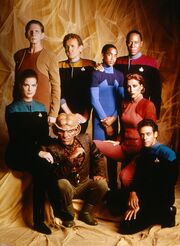
The first season promotional image of the cast of Deep Space Nine
Starring [ ]
- Avery Brooks as Commander / Captain Benjamin Sisko
Also starring [ ]
- Rene Auberjonois as Odo
- Nicole de Boer as Ensign / Lieutenant jg Ezri Dax ( 1998 - 1999 )
- Michael Dorn as Lt. Commander Worf ( 1995 - 1999 )
- Siddig El Fadil as Doctor Bashir
- Terry Farrell as Lieutenant / Lt. Commander Jadzia Dax ( 1993 - 1998 )
- Cirroc Lofton as Jake Sisko
- Colm Meaney as Chief O'Brien
- Armin Shimerman as Quark
- Nana Visitor as Major / Colonel Kira
Special guest stars [ ]
- Steven Berkoff as Hagath
- Rosalind Chao as Keiko O'Brien
- Jeffrey Combs as Weyoun
- Meg Foster as Onaya
- Jonathan Frakes as Thomas Riker / William T. Riker
- Louise Fletcher as Winn Adami
- Salome Jens as the Female Changeling
- Penny Johnson as Kasidy Yates
- Richard Kiley as Gideon Seyetik
- Richard Libertini as Akorem Laan
- Andrea Martin as Ishka
- Bill Mumy as Kellin
- Brock Peters as Joseph Sisko
- Andrew Robinson as Elim Garak
- Tim Russ as Tuvok
- William Sadler as Sloan
- Michael Sarrazin as Trevean
- Wallace Shawn as Grand Nagus Zek
- Kurtwood Smith as Thrax
- Patrick Stewart as Jean-Luc Picard / Locutus of Borg
- Leigh Taylor-Young as Yanas Tigan
- Clarence Williams III as Omet'iklan
Special appearances by [ ]
- Bernie Casey as Calvin Hudson
- James Darren as Vic Fontaine
- Robert Picardo as Lewis Zimmerman / Emergency Medical Holographic program
- Chris Sarandon as Martus Mazur
- Vanessa Williams as Arandis
Recurring characters [ ]
- Cecily Adams and Andrea Martin as Ishka
- Marc Alaimo as Gul Dukat
- Philip Anglim as Vedek Bareil
- Casey Biggs as Damar
- Jeffrey Combs as Liquidator Brunt
- Max Grodénchik as Rom
- Aron Eisenberg as Nog
- Hana Hatae as Molly O'Brien
- J.G. Hertzler as General Martok
- Barry Jenner as Admiral Ross
- David B. Levinson as Broik
- Kenneth Marshall as Michael Eddington
- Chase Masterson as Leeta
- Robert O'Reilly as Chancellor Gowron
- Duncan Regehr as Shakaar
- Andrew J. Robinson as Elim Garak
- Mark Allen Shepherd as Morn
Executive producers [ ]
- Rick Berman – Executive Producer
- Michael Piller – Executive Producer (1993–1995)
- Ira Steven Behr – Executive Producer (1995–1999)
Staff writers [ ]
- Ira Steven Behr , Staff Writer
- Hans Beimler , Staff Writer (1995–1999)
- René Echevarria , Staff Writer ( 1994 –1999)
- Ronald D. Moore , Staff Writer (1994–1999)
- Bradley Thompson , Staff Writer ( 1996 –1999)
- David Weddle , Staff Writer (1996–1999)
- Robert Hewitt Wolfe , Staff Writer (1993– 1997 )
Episode list [ ]
Season 1 [ ].
DS9 Season 1 , 19 episodes:
Season 2 [ ]
DS9 Season 2 , 26 episodes:
Season 3 [ ]
DS9 Season 3 , 26 episodes:
Season 4 [ ]
DS9 Season 4 , 25 episodes:
Season 5 [ ]
DS9 Season 5 , 26 episodes:
Season 6 [ ]
DS9 Season 6 , 26 episodes:
Season 7 [ ]
DS9 Season 7 , 25 episodes:
Related topics [ ]
- DS9 directors
- DS9 performers
- DS9 recurring characters
- DS9 studio models
- DS9 writers
- Character crossover appearances
- Undeveloped DS9 episodes
- Paramount Stage 4
- Paramount Stage 17
- Paramount Stage 18
- Star Trek: Deep Space Nine novels
- Star Trek: Deep Space Nine comics (IDW)
- Star Trek: Deep Space Nine comics (Malibu)
- Star Trek: Deep Space Nine comics (Marvel)
- Star Trek: Deep Space Nine soundtracks
- Star Trek: Deep Space Nine on VHS
- Star Trek: Deep Space Nine on LaserDisc
- Star Trek: Deep Space Nine on DVD
External links [ ]
- List of Star Trek: Deep Space Nine characters at Wikipedia
- Star Trek: Deep Space Nine at Memory Beta , the wiki for licensed Star Trek works
- Star Trek: Deep Space Nine at the Internet Movie Database
- Star Trek: Deep Space Nine at TV.com
- Star Trek: Deep Space Nine episodes at the iTunes Store
- Star Trek: Deep Space Nine at StarTrek.com
- Star Trek: Deep Space Nine at Wikiquote
- 2 USS Enterprise (NCC-1701-G)
- 3 Star Trek: The Next Generation
Join or Sign In
Sign in to customize your TV listings
By joining TV Guide, you agree to our Terms of Use and acknowledge the data practices in our Privacy Policy .
- Seasons & Episodes
- TV Listings
- Cast & Crew
Star Trek: Deep Space Nine - Full Cast & Crew
- 74 Metascore
- Drama, Action & Adventure, Science Fiction
- Watchlist Where to Watch
Different races try to coexist peacefully in the third 'Star Trek' spin-off. This one takes place on a 24th-century space station that serves as a frontier town on the edge of a wormhole that enables travellers to journey vast distances in short periods of time.
Screenwriter
Executive producer, cinematographer, production company, art director, sound effects, special effects.
WHERE ARE THEY NOW: The cast of 'Star Trek: The Original Series'
- " Star Trek " debuted 56 years ago on September 8, 1966.
- After the show, the cast of the original series remained sci-fi icons.
- Only three stars of " The Original Series " are alive today, after Nichelle Nichols' death in July.
William Shatner led the crew of the USS Enterprise as Captain James T. Kirk.
"Star Trek" was originally going to be focused on a different captain, Captain Christopher Pike, played by Jeffrey Hunter. A pilot was even filmed, called "The Cage," but it didn't make it to airwaves until the '80s. Gene Roddenberry, the creator, eventually retooled the show and cast Shatner as a new captain, Kirk. Some footage from "The Cage" was then reused for a season one episode called "The Menagerie."
Before "Star Trek," Shatner was famous for his role in an iconic " Twilight Zone " episode, "Nightmare at 20,000 Feet," in which he played a man recently released from a mental hospital who becomes convinced he can see a creature on the wing of the plane he's flying on. It aired in 1963, three years before "Star Trek."
In addition to his "Star Trek" roles, Shatner acted in "T.J. Hooker" and "Boston Legal," hosted "Rescue 911," and he has written numerous books. He finally made it to the final frontier in October 2021.
Though he's 91 years old, Shatner has shown no signs of slowing down. After "Star Trek" was canceled in 1969, he briefly returned to voice Kirk for the "Star Trek" animated series. In 1979, he again reprised his role as Kirk in " Star Trek: The Motion Picture ." He'd continue to do so regularly until 1994's "Star Trek Generations." He even directed one of the "Star Trek" movies: " Star Trek V: The Final Frontier. "
Besides "Star Trek," Shatner starred as the titular police officer on the '80s procedural "T.J. Hooker" and narrated " Rescue 911 ," a show that consisted of dramatic reenactments of real crimes.
Other roles that you might recognize Shatner from: a pageant host in " Miss Congeniality ," attorney Dennis Crane in " The Practice " and its spin-off " Boston Legal " for which he won two Emmys , and in the 2016-2018 reality show " Better Late Than Never ," in which Shatner, Henry Winkler, George Foreman, and Terry Bradshaw traveled around the world and experienced different cultures.
The actor is set to appear in the upcoming "Masters of the Universe: Revolution" series on Netflix. He also finally made it to space himself during a Blue Origin flight in October 2021, making him the oldest person to go into space at 90.
Shatner has written multiple books, both fiction and non-fiction over the course of his career. His 2016 book, " Leonard: My Fifty-Year Friendship with a Remarkable Man ," was about his friendship with "Star Trek" co-star Leonard Nimoy, who played his on-screen better half, Commander Spock.
Walter Koenig was cast as Ensign Pavel Chekov because of his resemblance to the Monkees' Davy Jones.
While Chekov was Russian, Koenig was born in America and based his accent on his parents' accents — they were Russian immigrants. Koenig was cast because, according to legend, he was supposed to help attract young girls as viewers due to his resemblance to teen idol Davy Jones. He even wore a Davy Jones-esque women's wig for the first seven or eight episodes, he told TV Insider in 2016.
Koenig's mainly recognized for his on-screen role as Chekov, though he became a pretty prolific screenwriter in the '70s. He wrote episodes for the "Star Trek" animated series, anthology series "What Really Happened to the Class of '65?" and children's series "Land of the Lost."
Koenig appeared in the 2018 film "Diminuendo."
Koenig, 85, (he's turning 86 on September 14) still makes frequent appearances on the "Star Trek" convention circuit, as well as acting in the occasional film. He appeared in 12 episodes of " Babylon 5 " in the '90s, voiced himself in an episode of "Futurama," and also voiced Mr. Savic on the Netflix animated series " Stretch Armstrong and the Flex Fighters. "
While not all of the "Star Trek" cast were on great terms, Koenig and his co-star George Takei remain close. Koenig was even the best man in Takei's wedding in 2008.
George Takei played Lieutenant Hikaru Sulu, a helmsman on the Enterprise.
Over the course of the show, Sulu was revealed to have many interests outside of Star Fleet, most famously fencing. At the time, Sulu was one of the first Asian characters on TV who wasn't explicitly a villain, and instead was a fully formed hero.
"Up until the time I was cast in 'Star Trek,' the roles were pretty shallow — thin, stereotyped, one-dimensional roles. I knew this character was a breakthrough role, certainly for me as an individual actor but also for the image of an Asian character: no accent, a member of the elite leadership team," Takei told Mother Jones in 2012.
Takei originally was supposed to play Sulu as an astrophysicist, but the role was changed to helmsman. Before "Star Trek," Takei also appeared in " The Twilight Zone " like his co-star William Shatner, among other '50s and '60s procedurals.
Takei is still acting to this day, though many people know him now for his social media presence.
Who says an 85-year-old doesn't know how to use social media? Takei's Facebook page has 9.5 million likes to date, and he has 3.4 million followers on Twitter .
In addition to his continued acting in films like "Paws of Fury: The Legend of Hank," " Kubo and the Two Strings ," "Blazing Samurai," and "Mulan," and TV shows like "Heroes," "Supah Ninjas," and " Star Wars: Visions ," Takei is an activist. He came out as gay in 2005 and began working as a spokesperson for the Human Rights Campaign.
Takei also starred in the 2012 musical "Allegiance," which was based on his and his family's experiences during Japanese internment in World War II.
Nichelle Nichols played Lieutenant Nyota Uhura, a translator, communications officer, and linguistics expert.
Uhura was one of the first Black television characters that didn't have a menial job — instead, she was in a position of power. She and Shatner were also involved in what is thought to be the first interracial kiss on American TV.
Nichols stayed with the show for all three seasons, but it wasn't without drama. She was tempted to leave during the first year, but none other than Martin Luther King Jr. convinced her to stay. She told the New York Post in 2011 that when she told him that she wanted to leave, he told her, "You can't do that. You have the first non-stereotypical, non-menial role on television. You have created strength and beauty and intelligence. For the first time, the world sees us as we should be seen. It's what we're marching for. You're a role model and whether you like it or not, you belong to history now."
She also released an album in 1967, "Down to Earth." In between "Star Trek's" cancellation and its return on the big screen, Nichols starred in the 1974 blaxploitation film " Truck Turner ," as Dorinda, a madam.
Nichols died in 2022 at the age of 89. She had retired from public appearances in 2018.
From 1977 until 2015, Nichols was involved with Women in Motion, a recruiting program for NASA to help get more women involved in the space program. In July 2020, a documentary about the program finally secured distribution and will be released in 2021, Deadline reported.
"Nichelle Nichols not only was a trailblazer in Hollywood, she was a trailblazer for the future of our society. She took the fight for Civil Rights, diversity and inclusion and gender equality to new frontiers with NASA which continue to serve America's space program today. She was ahead of her time," said executive producer Ben Crump.
Nichols also appeared in " The Young and the Restless, " "Heroes," and " Futurama ." She was diagnosed with dementia in 2018 and subsequently retired from public appearances.
In July 2022, Nichols' son announced on social media that Nichols had died at the age of 89 .
Leonard Nimoy played Captain Kirk's first officer and close friend Commander Spock.
Spock was the only alien member of the original crew, as he was half-human, half-Vulcan — an alien race from the planet Vulcan whose residents operate solely from a point of logic, not feelings. Much of the show's comedy came from Spock and Kirk's differences and their amusement at each other. His frequent farewell, " Live Long and Prosper ," accompanied by the Vulcan Salute, are among the most recognizable pieces of the "Star Trek" canon.
Nimoy had multiple small parts in B movies and TV shows before booking "Star Trek," including an episode of " The Man from U.N.C.L.E. " alongside future co-star William Shatner, as well as an episode of " The Twilight Zone ."
But once "Star Trek" premiered, Nimoy would be forever linked with his Vulcan counterpart, and he mainly did voice work after the show ended. He also reunited with Shatner for an episode of his show, "T.J. Hooker."
Nimoy died in 2015 at the age of 83. He played Spock for the final time in 2013's "Star Trek Into Darkness," meaning he played the role for almost 50 years.
Nimoy is the only actor from the original series to appear in JJ Abrams' rebooted films, as he appeared in 2009's "Star Trek" and its 2013 sequel " Star Trek Into Darkness " as an older version of Spock who was trapped in an alternate universe.
In addition to acting, Nimoy was a photographer, recording artist, author, and director. He directed two "Star Trek" movies (" The Search for Spock " and "The Journey Home"), and "Three Men and a Baby," which became the highest-grossing film of 1987 .
Nimoy died in 2015 at the age of 83 due to chronic obstructive pulmonary disease (COPD).
DeForest Kelley played the ship's curmudgeonly chief medical officer, Dr. Leonard "Bones" McCoy.
Bones, as he was affectionately called, was one of the oldest members of the crew, and thus got to be a bit more obnoxious than the rest of them. His frequent catchphrase, " I'm a doctor, not a ___, " is one of the most parodied lines of dialogue from the show.
Like his character, Kelley was older and a more established actor than the rest of the cast. Before the show, he had appeared in Westerns and historical films like " Gunfight at the O.K. Corral ," "Warlock," and " Raintree County " in the '50s.
Kelley died in 1999 at the age of 79, nine years after playing McCoy for the last time.
Kelley essentially retired from acting, besides playing McCoy, after the success of "Star Trek." He appeared in all six films starring the original cast, and appeared in an episode of " Star Trek: The Next Generation " as McCoy, as well.
While he wasn't much of a sci-fi fan, Kelley was proud of his "Star Trek" legacy. When asked what he thought his legacy would be, he explained that his character inspired people to enter the medical field. He told the New York Times , "These people [fans] are doctors now, all kinds of doctors who save lives. That's something that very few people can say they've done. I'm proud to say that I have.''
He died in 1999 at the age of 79 due to stomach cancer .
Majel Barrett had a recurring role as Nurse Christine Chapel.
Barrett was originally cast in the first version of "Star Trek" as Pike's first officer, but when that episode was scratched, so was her character. However, due to her romantic relationship with "Star Trek" creator Gene Roddenberry (who she later married), she was brought back as Nurse Chapel (a divisive character).
Before the show, Barrett was in various bit parts in '50s and '60s shows, but her big break was " Star Trek ," which she stayed involved in for the rest of her life.
Barrett died in 2008 when she was 76 years old. Up until her death, she had been involved with every "Star Trek" series in some way, leading fans to call her the First Lady of "Star Trek."
Barrett reprised her role as Chapel in " Star Trek: The Motion Picture " and " Star Trek IV: The Voyage Home ." She also appeared in " Star Trek: The Next Generation " and "Star Trek: Deep Space Nine" as Lwaxana Troi, the mother of Deanna Troi, a main character in "Next Generation." Her other involvement in the series was the voice of the computer in many of the other " Star Trek" films: "Generations ," " First Contact ," "Nemesis," and 2009's reboot.
She died in 2008 at the age of 76 due to leukemia .
James Doohan played chief engineering officer Montgomery "Scotty" Scott.
Contrary to popular belief, the phrase " Beam me up, Scotty " is never actually uttered in the original series. The man on the other end of that command, Scotty, was played by Doohan, who was Canadian in real life, not Scottish.
Before "Star Trek," Doohan served in the Canadian military and was even on the beaches of Normandy during D-Day, and was a pilot as well. After the war, he began acting and became a successful radio actor. Like his co-stars, he also appeared in an episode of " The Twilight Zone ," and other popular procedurals.
In the animated series, Doohan proved to be indispensable, with his talent for voice acting and accents. He voiced over 50 characters during the show's run.
James Doohan died at the age of 85 in 2005.
Doohan didn't find much success outside of the world of "Star Trek," and thus embraced his role as Scotty. He appeared in "Generations," as well as an episode of " The Next Generation ."
However, his impact on the field of engineering cannot be overstated. He was awarded an honorary doctorate from the Milwaukee School of Engineering "after half the students there said that Scotty had inspired them to take up the subject," according to the BBC .
Towards the end of his life, Doohan suffered from Parkinson's and Alzheimer's, and retired from public life in 2004. He died the following year, at 85, due to complications from pneumonia .
Grace Lee Whitney appeared in the first season of the show as Yeoman Janice Rand.
Rand appeared in eight episodes of the show's first 15-episode season as a clerical and administrative worker aboard the ship, before Whitney was released from her contract. At the time, the story was that the show didn't have enough money to keep everyone, but years later in her autobiography, Rand accused an unnamed executive producer , whom she called "The Executive," of sexually assaulting her.
"I tried to do what he wanted me to, so I could get it over with. I knew, deep down inside, that I was finished on 'Star Trek.' At that moment, however, I didn't care about that. Nothing else mattered — not my tarnished virtue, not my career, not my role on 'Star Trek.' The only thing that mattered was getting out of that room alive," she wrote.
Whitney died in 2015 at the age of 85.
After getting written off the show, Whitney struggled with her career, and alcoholism. She credited co-star Leonard Nimoy with helping her get back on her feet and involved with "Star Trek" once again. She reprised her role in four of the original "Star Trek" films, and in an episode of " Star Trek: Voyager " alongside George Takei.
She died in 2015 due to natural causes at the age of 85.
When you buy through our links, Insider may earn an affiliate commission. Learn more .
- Main content
- More to Explore
- Series & Movies
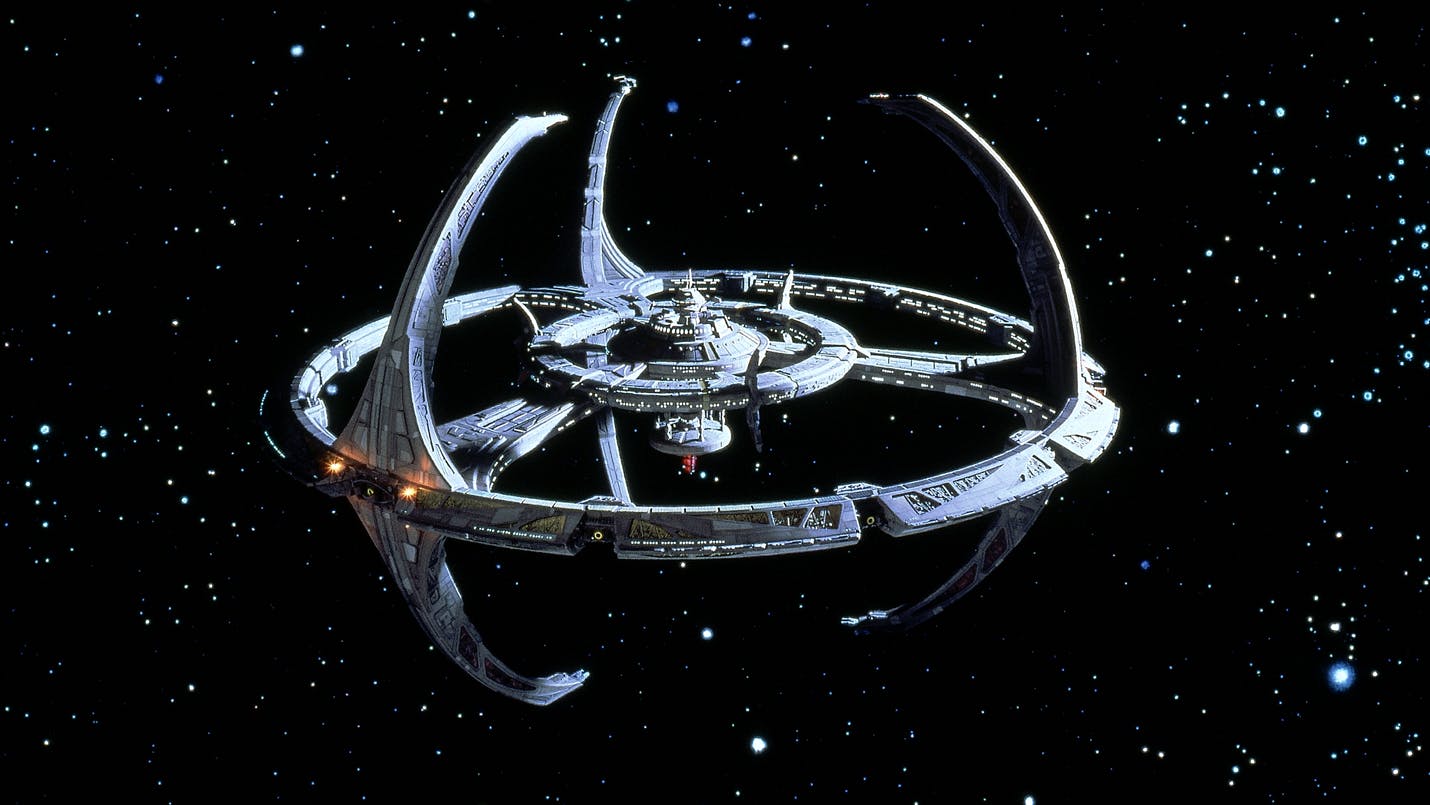
Star Trek: Deep Space Nine
Cast of characters.
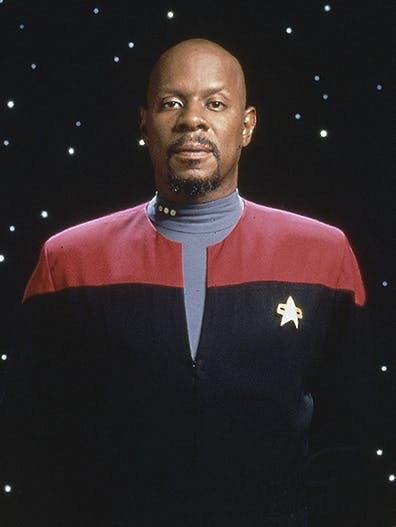
Latest Articles
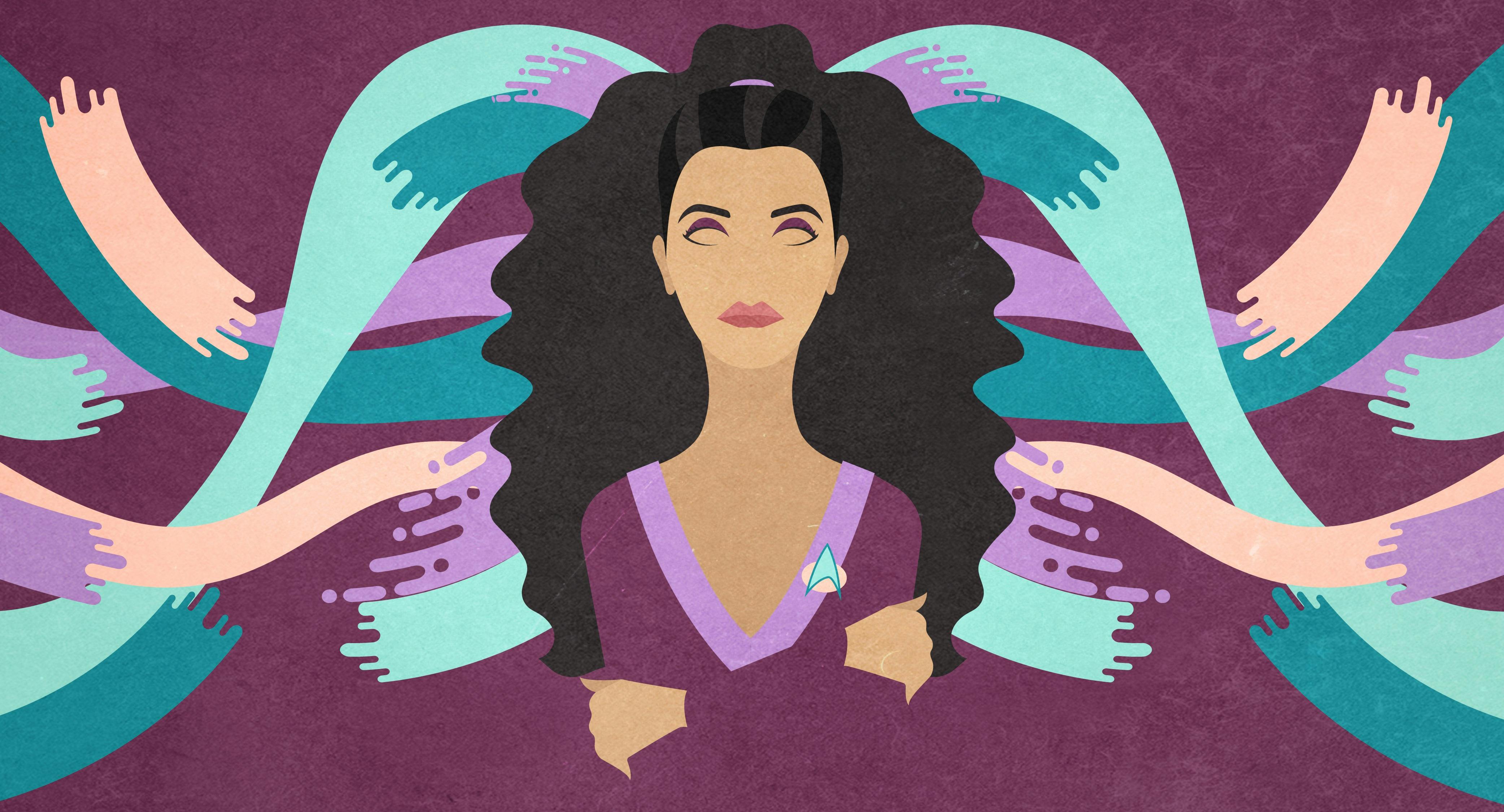
- Latest Articles See More
Latest Videos
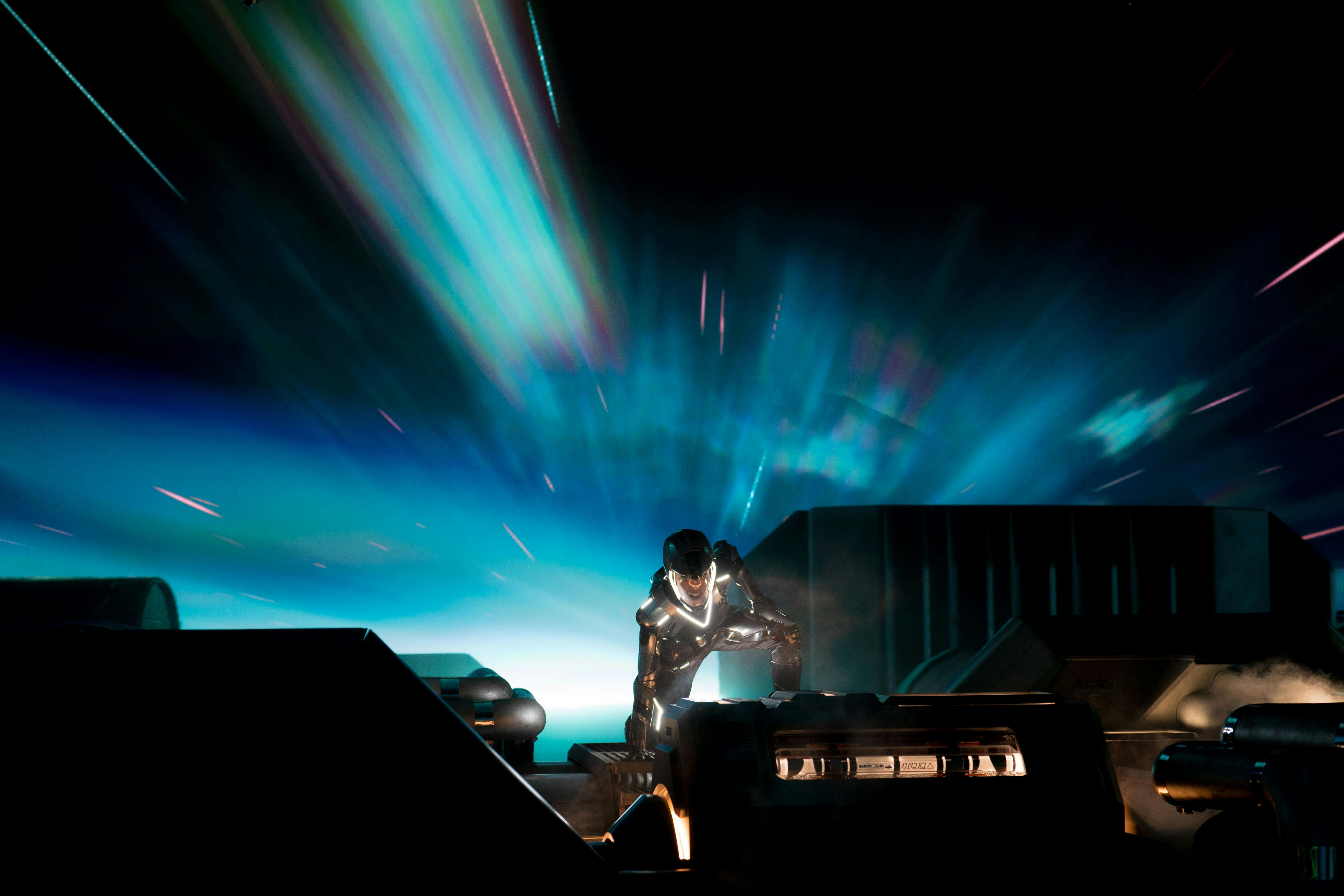
- Latest Videos See More

Latest Galleries
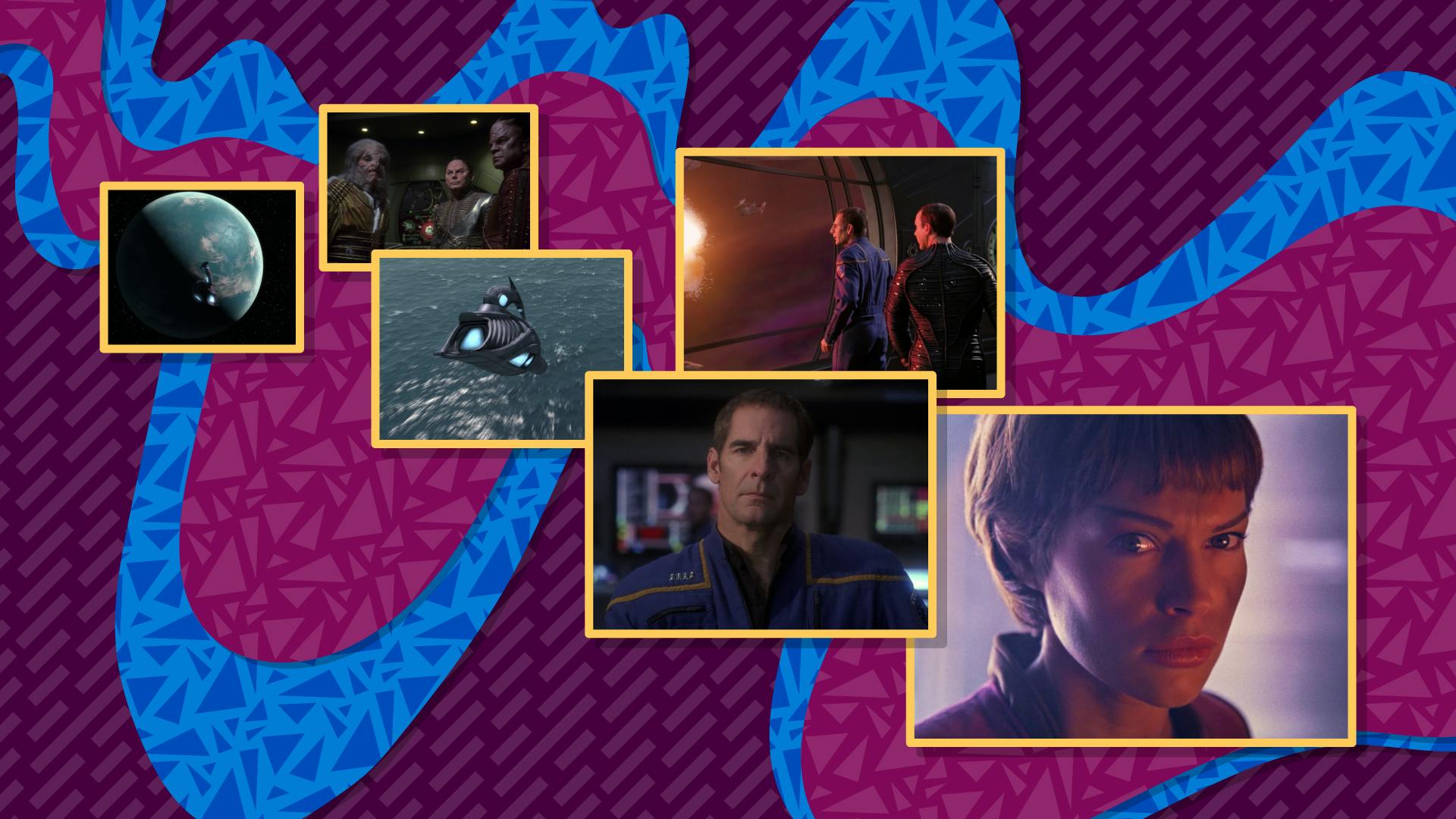
- Latest Galleries See More
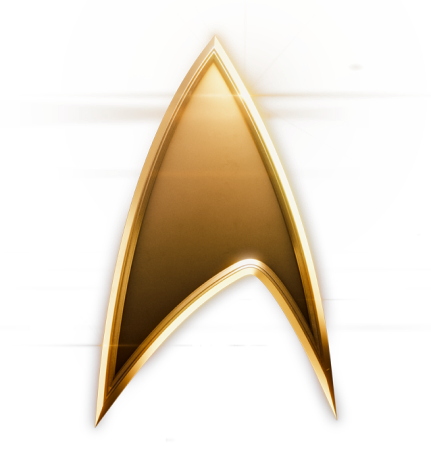
Boldly Go: Subscribe Now
The Cast Of Star Trek: Then And Now
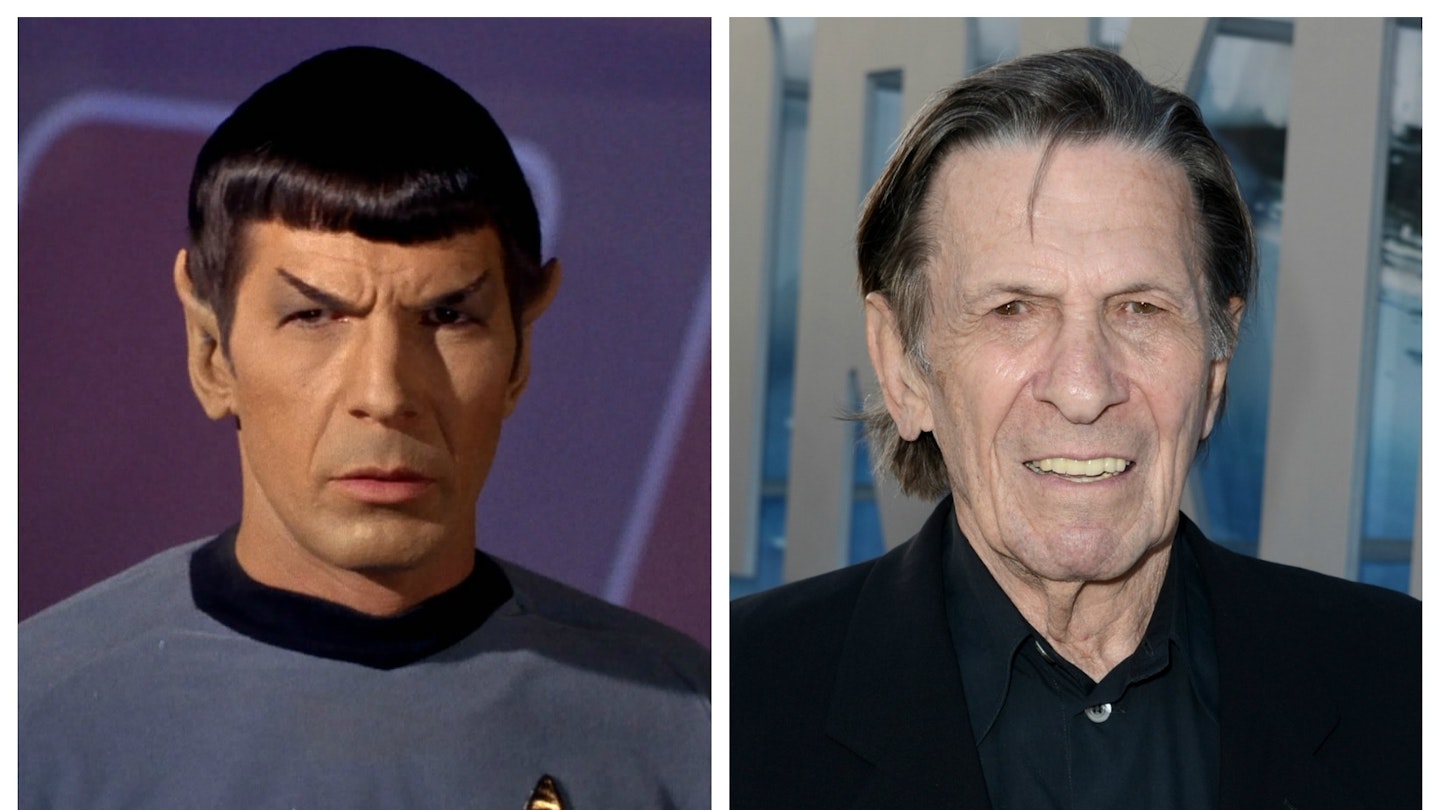
Over 50 years since it first aired, Star Trek remains a cultural juggernaut – from the J.J. Abrams -driven big-screen saga, to the forthcoming return of The Next Generation , and the continuation of Star Trek Discovery on Netflix (where you can also find every episode of every Trek show, including the animated series). In salute to Gene Roddenberry's groundbreaking, iconic show, we take stock of those original actors who paved the way for everything that followed.
William Shatner
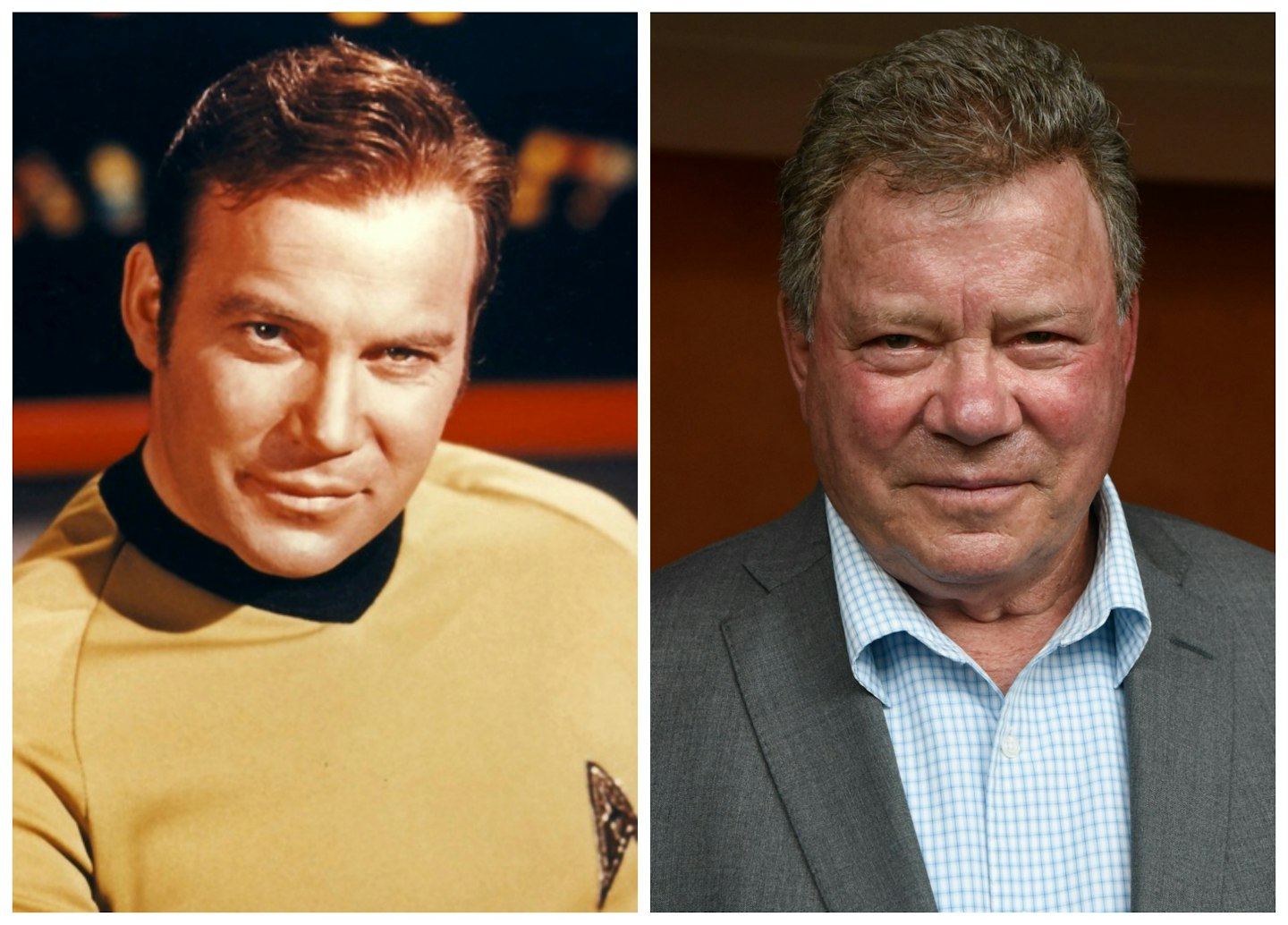
Cast as captain of the starship Enterprise, it was Shatner who set the standard as James T. Kirk. Born in 1931 in Canada, and having a career that has spanned television, stage, screen, novels, video games, comic books, music and lord knows what else, this is a an 85-year-old who will not stop until he drops, and even then he’d probably argue, “What does God need with a starship…captain?”
Leonard Nimoy
Mr. Spock was far from the first television sidekick to equal if not eclipse a TV show’s main star. Given what Shatner brought to Kirk, it’s says a lot about Leonard Nimoy’s ability that he could make a character in complete control (most of the time) of his emotions come across as more than a cardboard cut-out. He never allowed Spock’s quiet dignity to fade away, even when reprising the role as recently as in J.J. Abrams’ Star Trek Into Darkness . Born in 1931, Nimoy enjoyed a working life in theatre, on TV and film (as both actor and director), and as an author, recording artist and photographer. He died on February 27, 2015, and received a touching tribute in Star Trek Beyond .
DeForest Kelley
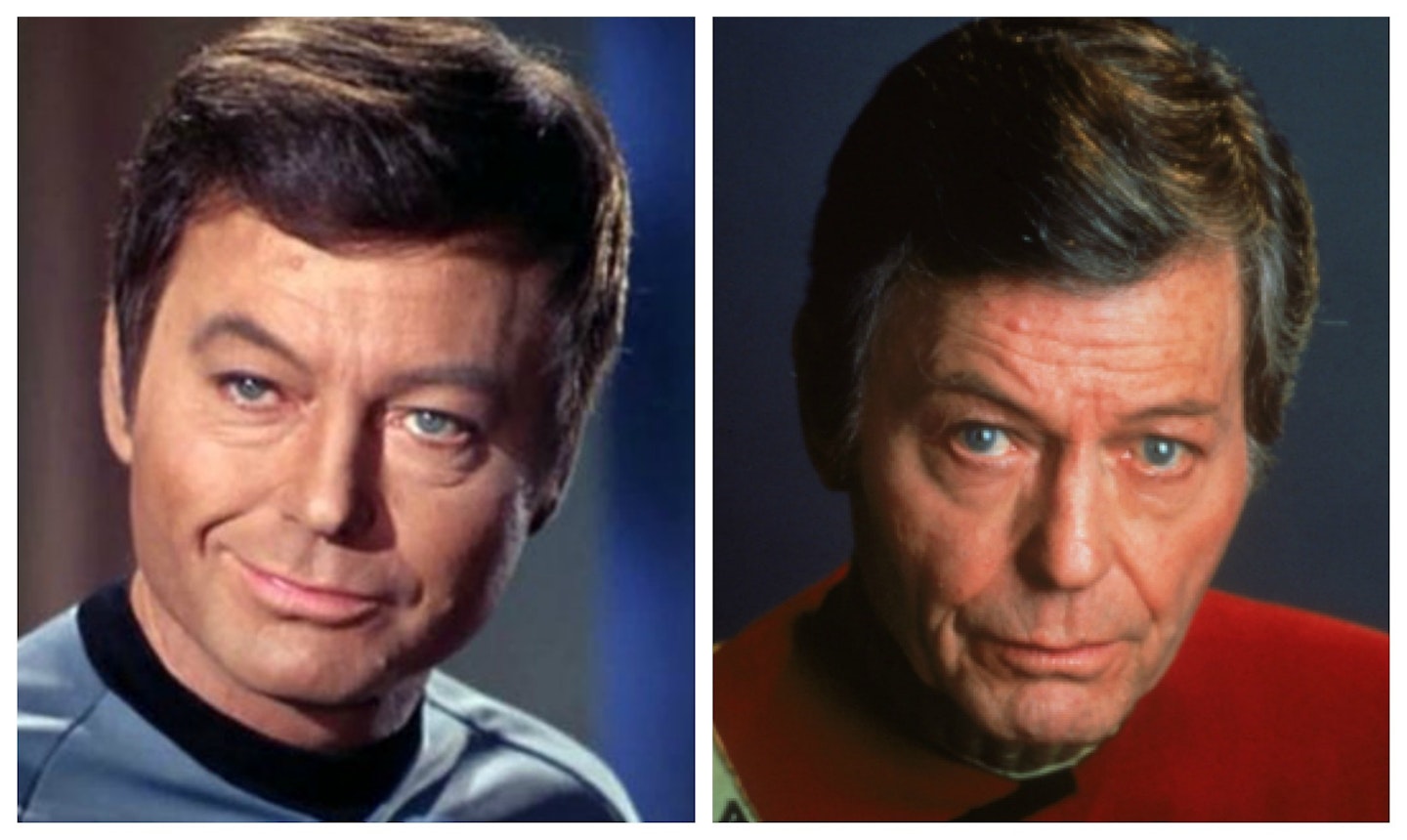
If there was one actor who brought the most humanity to Star Trek , it had to be the late DeForest Kelley as Dr. Leonard 'Bones' McCoy. Born in 1920, he had built a career playing TV bad guys, usually in Westerns, which is what made it so surprising when Roddenberry cast him as The Enterprise's chief medical officer and Kirk’s conscience. After Star Trek finished its run, Kelley took on a couple of roles, but pretty much retired except for conventions, the first six big screen Star Trek adventures and a guest spot on the premiere episode of The Next Generation . He died on June 11, 1999.
James Doohan
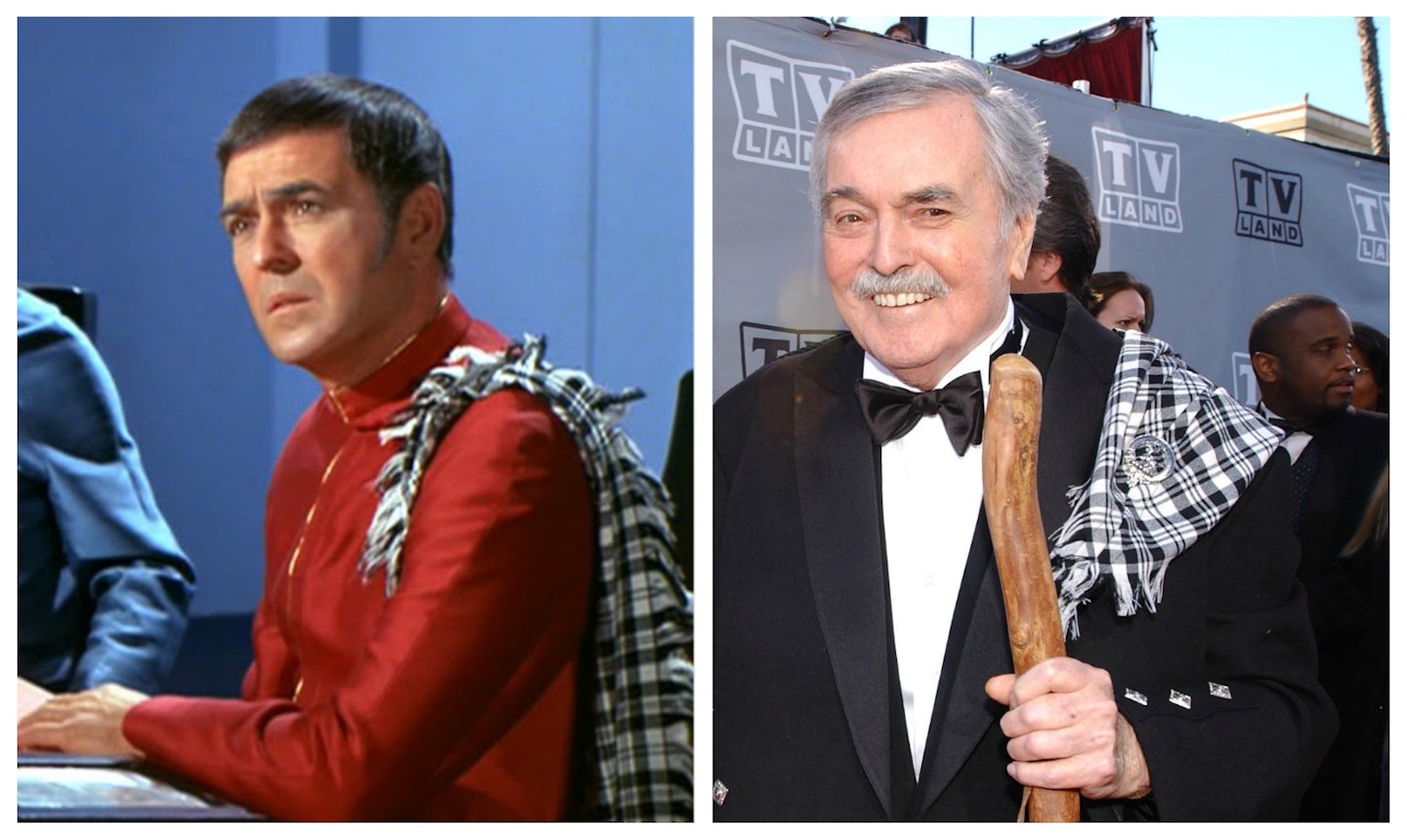
He gave the engines all they had…and then some. It’s why James Doohan’s chief engineer, Montgomery 'Scotty' Scott,” was the best in the fleet. Born in in Canada in 1920, Doohan enjoyed a career in Canadian radio and television before making the shift to America. Like many of his co-stars, following the end of Star Trek he found himself typecast and other acting opportunities difficult to come by. He scored character roles here and there, and, of course, reprised the role of Scotty in the feature films based on the show. He died on July 20, 2005.
Nichelle Nichols
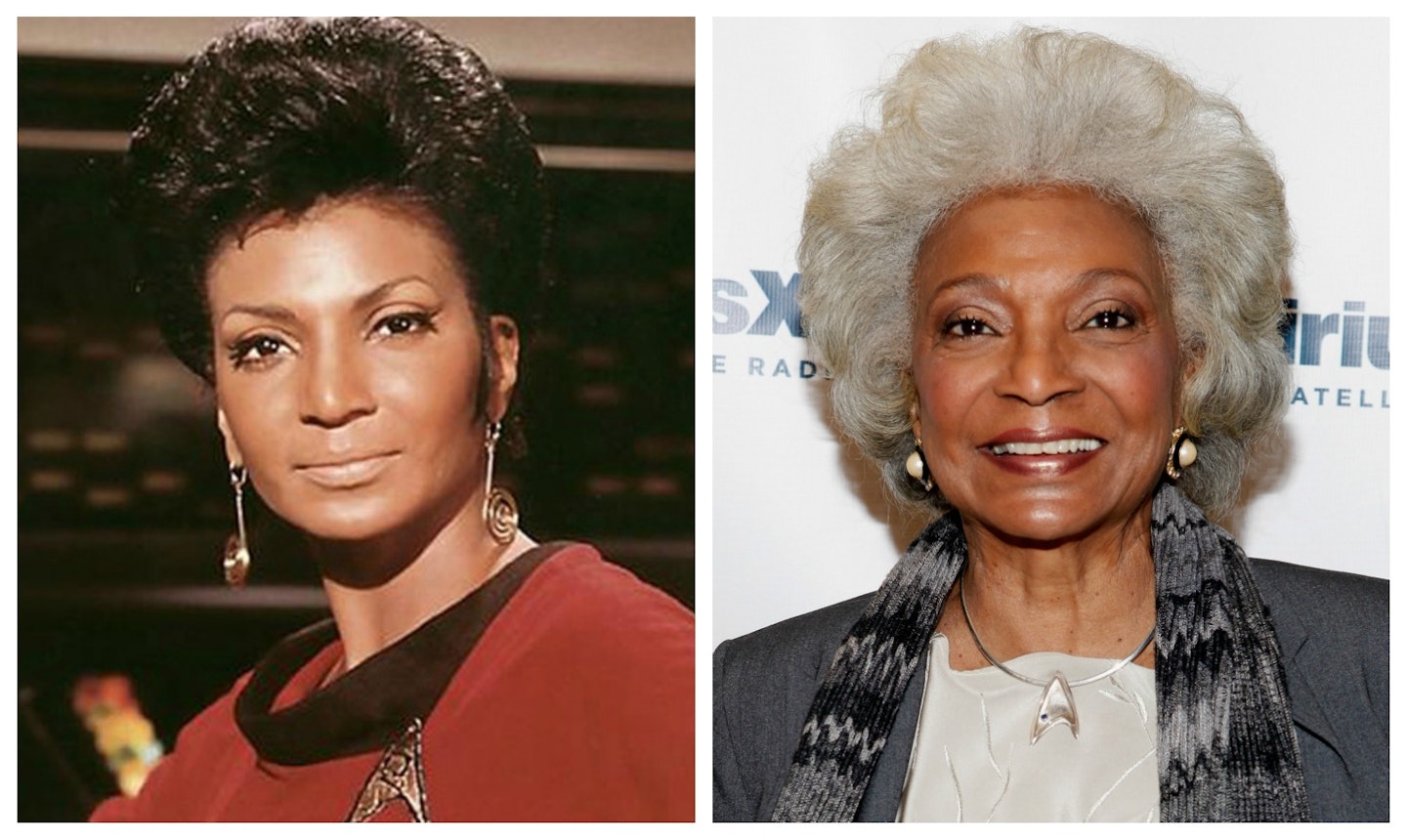
She opened those hailing frequencies like a boss, making communications officer Uhura an essential member of the Enterprise bridge crew. Born in 1932, Nichols took on the laudable challenge of being an African American actress on television at a time when America was struggling with civil rights. As such, she became a symbol and an inspiration for many African-American women. Early in her career she enjoyed some success as a dancer and singer, eventually making her way to television, where she met Gene Roddenberry on The Lieutenant . When he was casting Trek , he knew he wanted her to be a part of it. For some years following the series acting roles were sparse, but she did parlay the growing popularity of Trek into a job at NASA, where she recruited minority and female personnel to the space agency.
George Takei
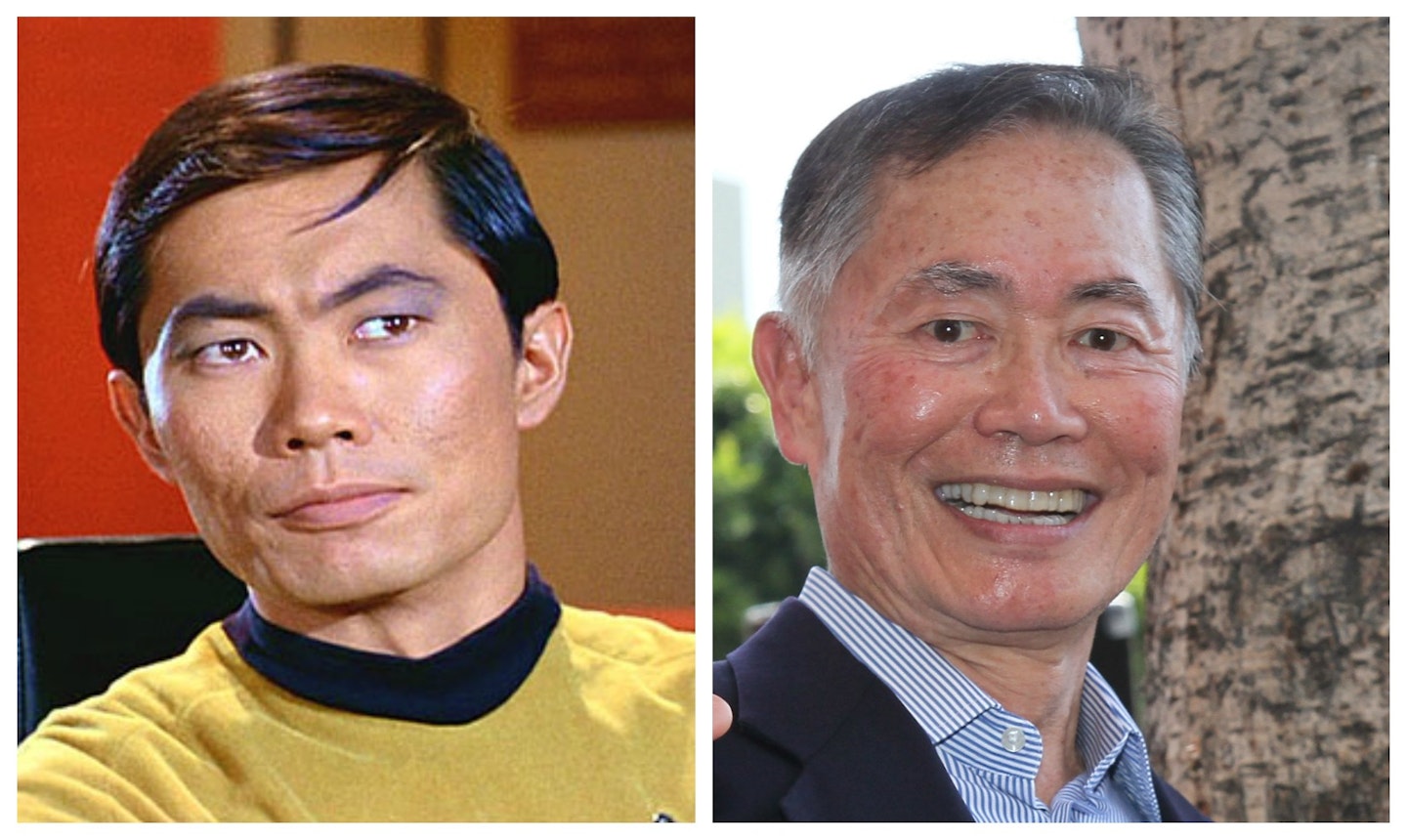
Like his co-stars, George Takei , born in 1937, spent many years trying to shake off the persona of Enterprise helmsman Hikaru Sulu. But after embracing all of what Star Trek represented, Takei enjoyed something of a career renaissance. He acted in mostly small roles before Trek , co-starred in John Wayne’s The Green Berets . Besides reprising the role of Sulu in six feature films, he immersed himself in California politics, became an author, and in recent years seems to be almost everywhere , appearing on a wide variety of TV shows and most recently on stage in the musical Allegiance , set during the Japanese American interment of World War II, which Takei himself experienced as a child.
Walter Koenig
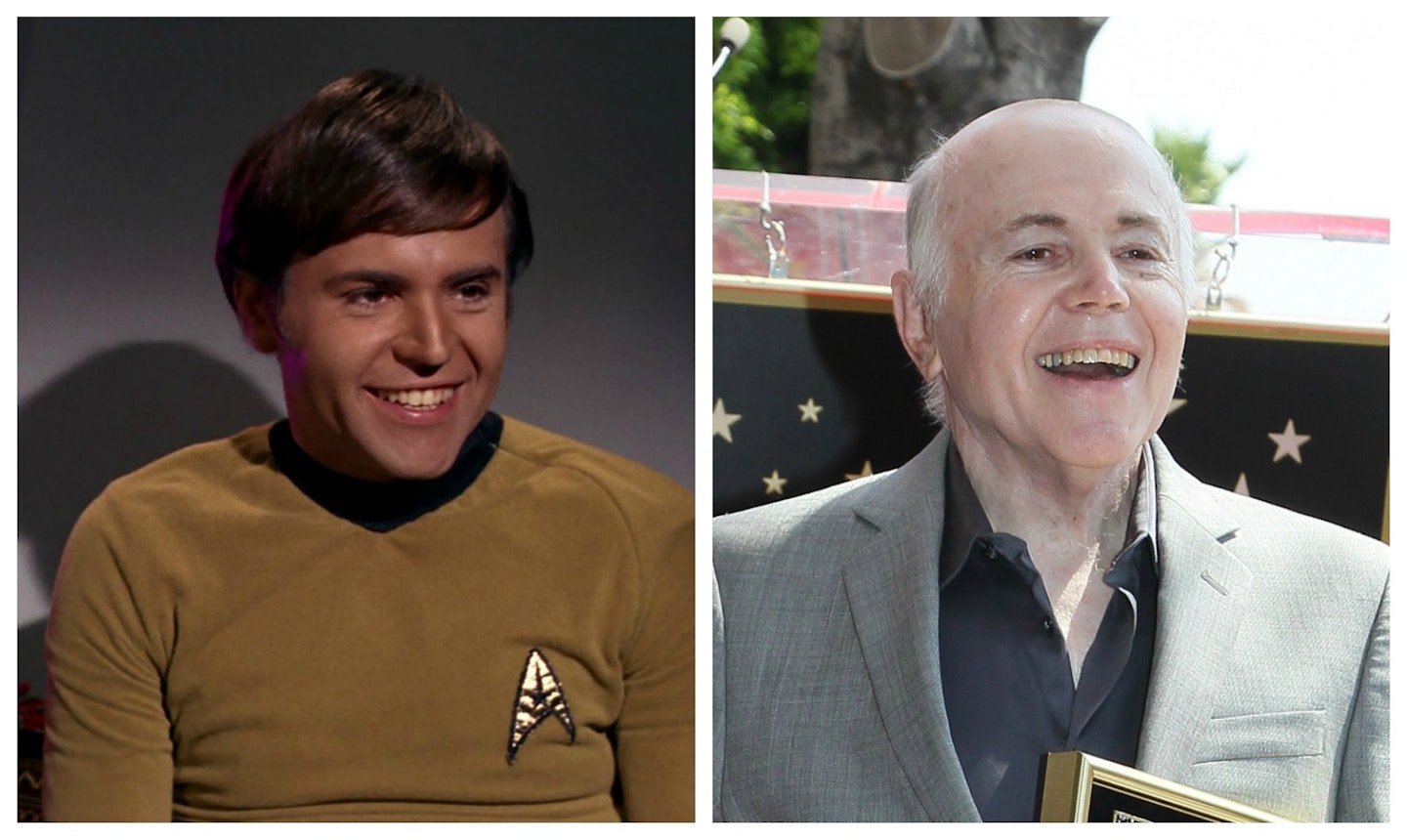
He joined Star Trek in its second season and, as navigator Pavel Chekov, was supposed to be the 23rd Century’s answer to the youth-appealing Monkees or The Beatles. Koenig was another actor who had come to Roddenberry’s attention through The Lieutenant , and was brought aboard the Enterprise in 1967, where he served through the remainder of the series and seven feature films (he joined Shatner and Doohan in 1994’s Star Trek: Generations ). In between he worked as a television writer, gained popularity for his portrayal of Alfred Bester in the series Babylon 5 and appeared in a number of films. He also wrote a number of books – both fiction and non-fiction – and worked in comics as well.
Notable Movie Guest Stars
Stephen collins.

He portrayed Commander Willard Decker in Star Trek: The Motion Picture . Born in 1947, Collins is best known for roles in in TV shows such as Tales of the Gold Monkey , No Ordinary Family and Revolution , as well as the films The First Wives Club and Because I Said So . He also spent eleven seasons as the patriarch on 7th Heaven .
Kirstie Alley
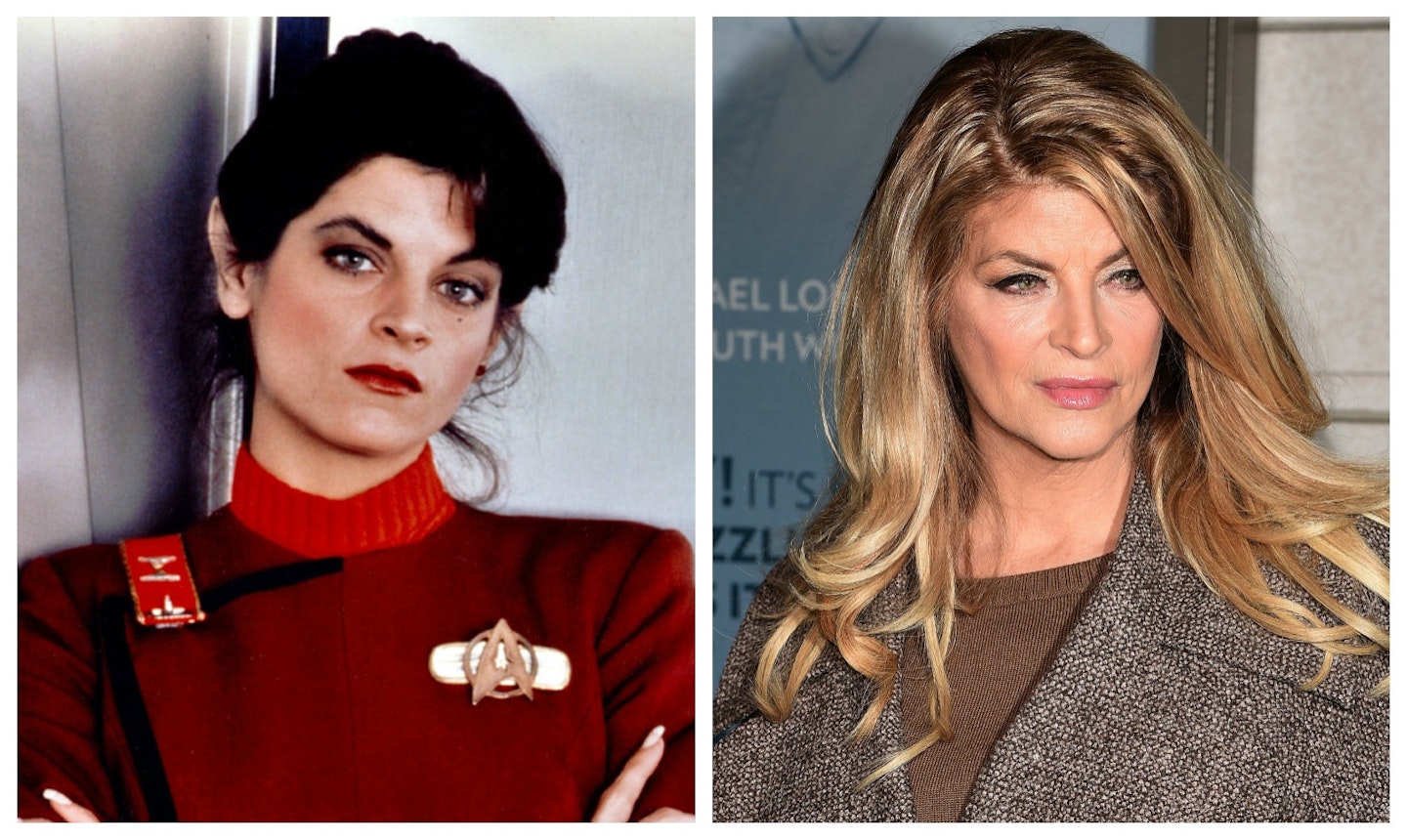
Born in 1951, Alley portrayed Vulcan/Romulan hybrid Lt. Saavik in 1982’s Star Trek II: The Wrath Of Khan . Following the film she co-starred in the long-running Cheers , and went on to such shows as Veronica’s Closet and Kirstie , a number of guest star appearances and starring roles in films Look Who’s Talking, It Takes Two, For Richer or Poorer and Accidental Love .
Ricardo Montalban
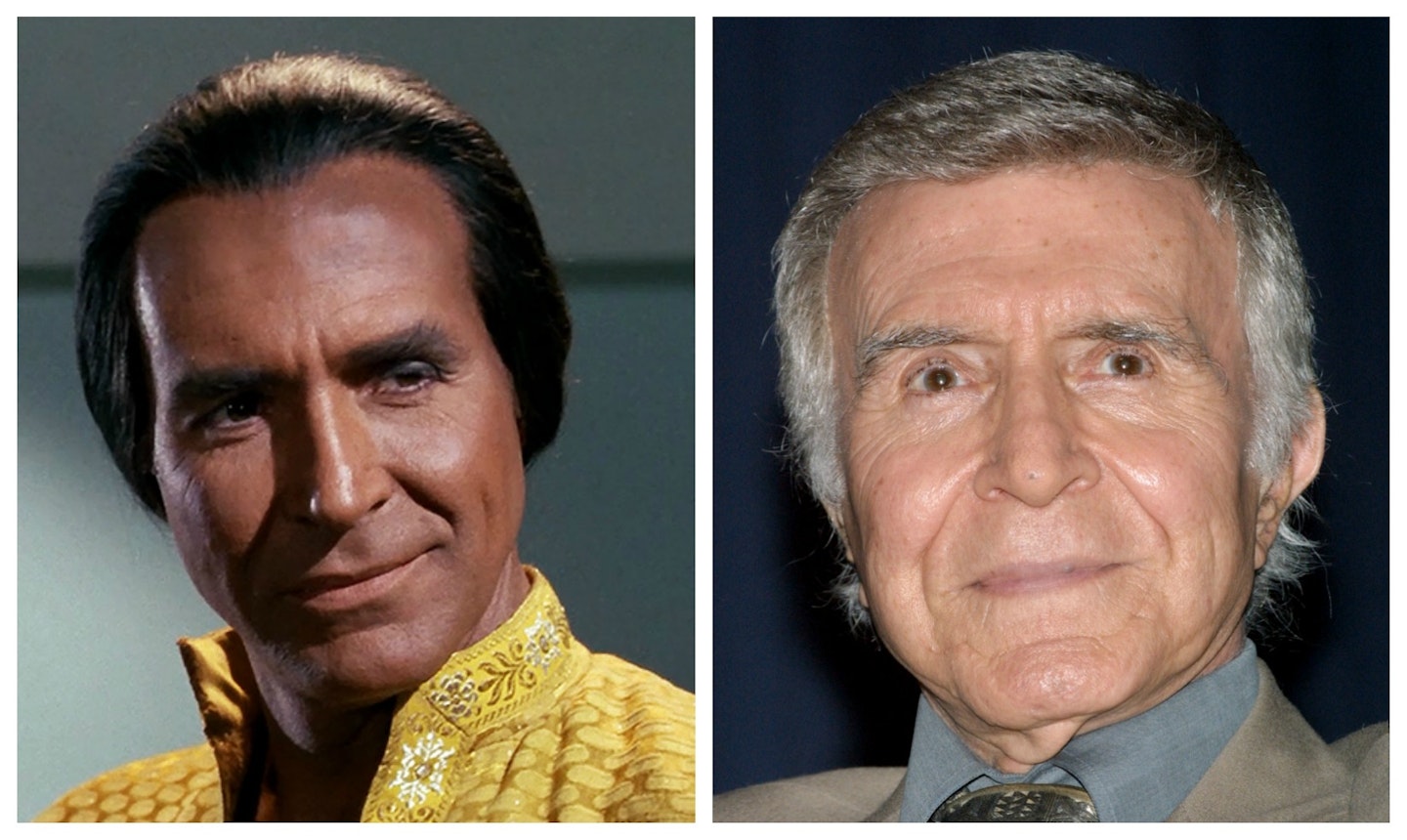
Montalban guest-starred on the original Star Trek in the 1967 episode “Space Seed,” portraying 20th Century genetic superman Khan Noonien Singh. Revived from suspended animation, Khan attempted to take control of the Enterprise and, instead of being sent to prison, was given a planet to tame by Kirk. After that, Montalban (born in 1920 in Mexico), just as he had before that show, appeared in a wide variety of TV series, television movies and feature films, but is largely remembered for playing Mr. Roarke in Fantasy Island and Zach Powers in Dynasty and The Colbys . In 1982 he reprised the role of Khan in Star Trek II: The Wrath of Khan , in which, as the title suggests, his genetic superman and his people escape the planet they had been left on, seeking vengeance against Kirk. Montalban died on January 14, 2009.
Christopher Lloyd
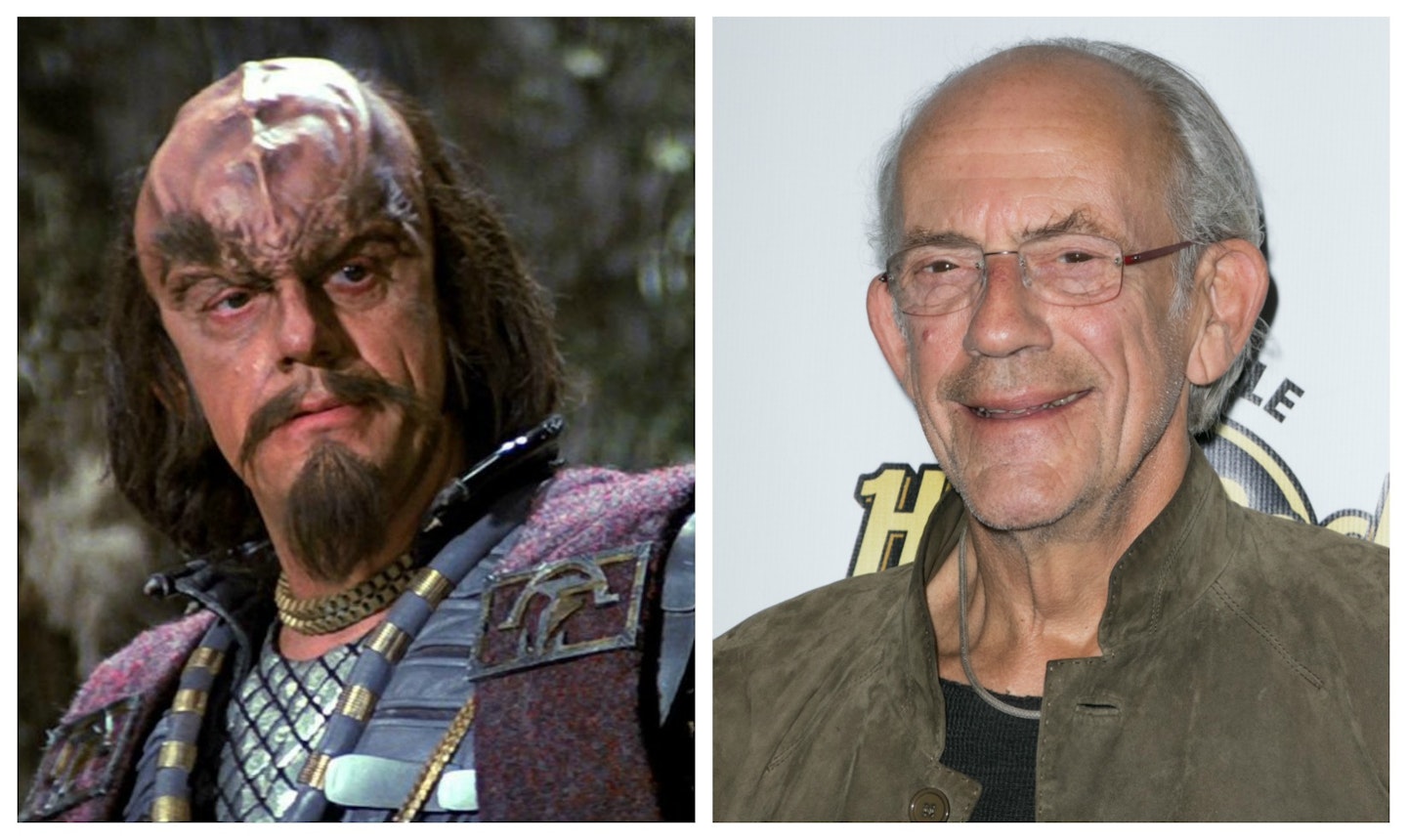
As the Klingon Kruge, Christopher Lloyd looked to be having a grand old time chewing the soundstage scenery with Shatner in 1984’s Star Trek III: The Search For Spock . Lloyd’s long list of credits include the TV series Taxi , as well as Who Framed Roger Rabbit? . He is undoubtedly most beloved for his role as Dr. Emmett Brown in the Back To The Future trilogy.
Robin Curtis

When contractual issues came up between Kirstie Alley and Paramount following Wrath Of Khan , Robin Curtis stepped in to play Lt. Saavik for Star Trek III: The Search For Spock and, briefly, Star Trek IV: The Voyage Home . Prior to her tour of duty on the Enterprise, she guest starred on some TV shows, appeared in several films and amassed an impressive number of regional and national theatre stage roles. Between acting gigs, she's also worked as a real estate agent.
Catherine Hicks
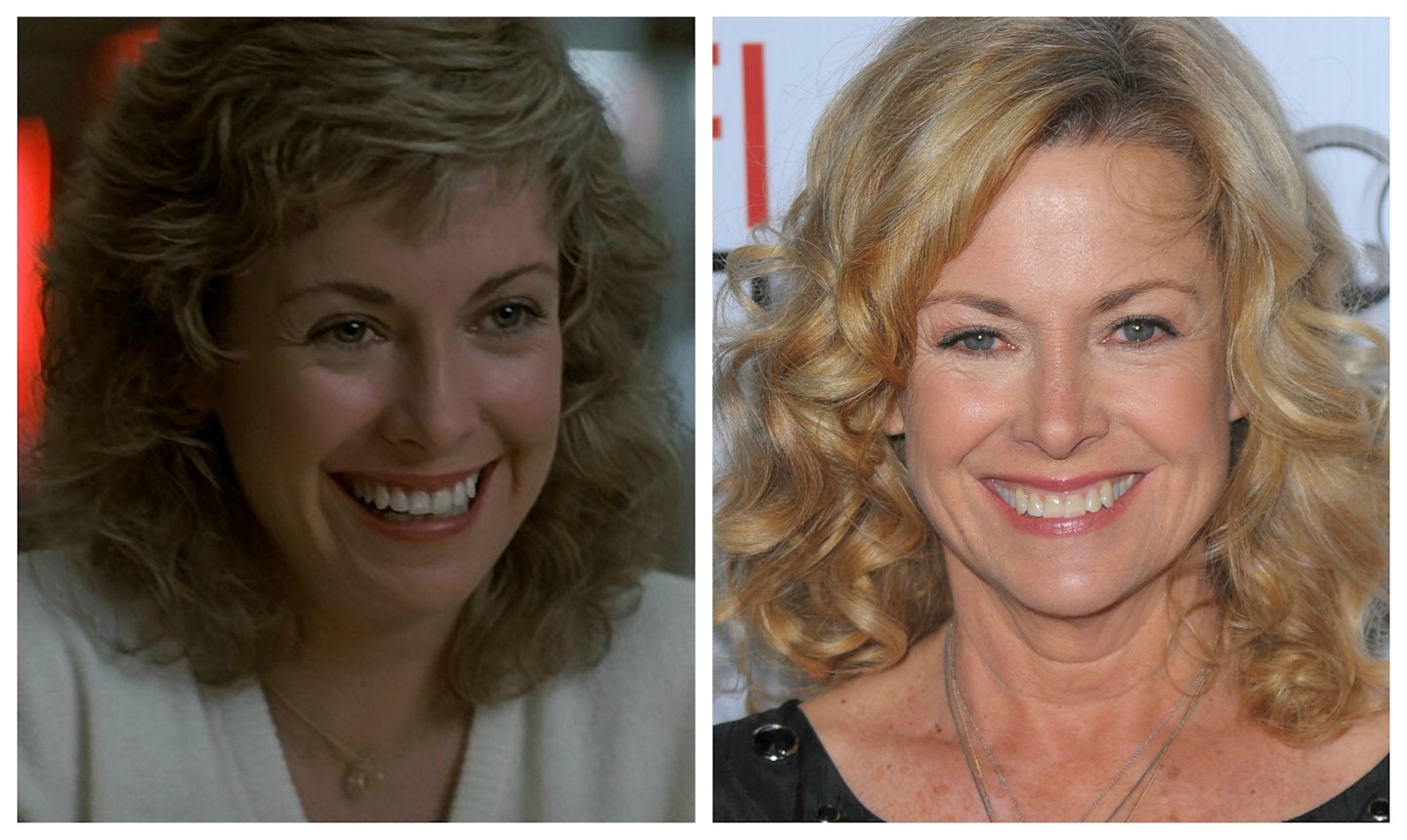
In the years prior to endearing herself to Star Trek fans as marine biologist Gillian Taylor in Star Trek IV , Catherine Hicks (born in 1951) had spent three years on the soap opera Ryan's Hope , starred in several short-lived series, was Emmy-nominated for her role as Marilyn Monroe in the TV movie Marilyn: The Untold Story and would go on to star in Child's Play . Most notably she co-starred with Commander Decker (actually Stephen Collins) in 7th Heaven , which ran for eleven seasons beginning in 1996.
Laurence Luckinbill

Did you know Spock had a half-brother named Sybok? Nope, neither did we. Even Kirk had no idea, but that was one of the revelations of 1989's Star Trek V: The Final Frontier , and it was Sybok who hi-jacked the Enterprise so everyone could meet (not) God. Laurence Luckinbill, born in 1934, has a long history of roles on television, stage and in film. He also happens to be married to Lucie Arnaz, daughter of Lucille Ball (who gave the green light for the original Star Trek in the first place) and Desi Arnaz.
Christopher Plummer
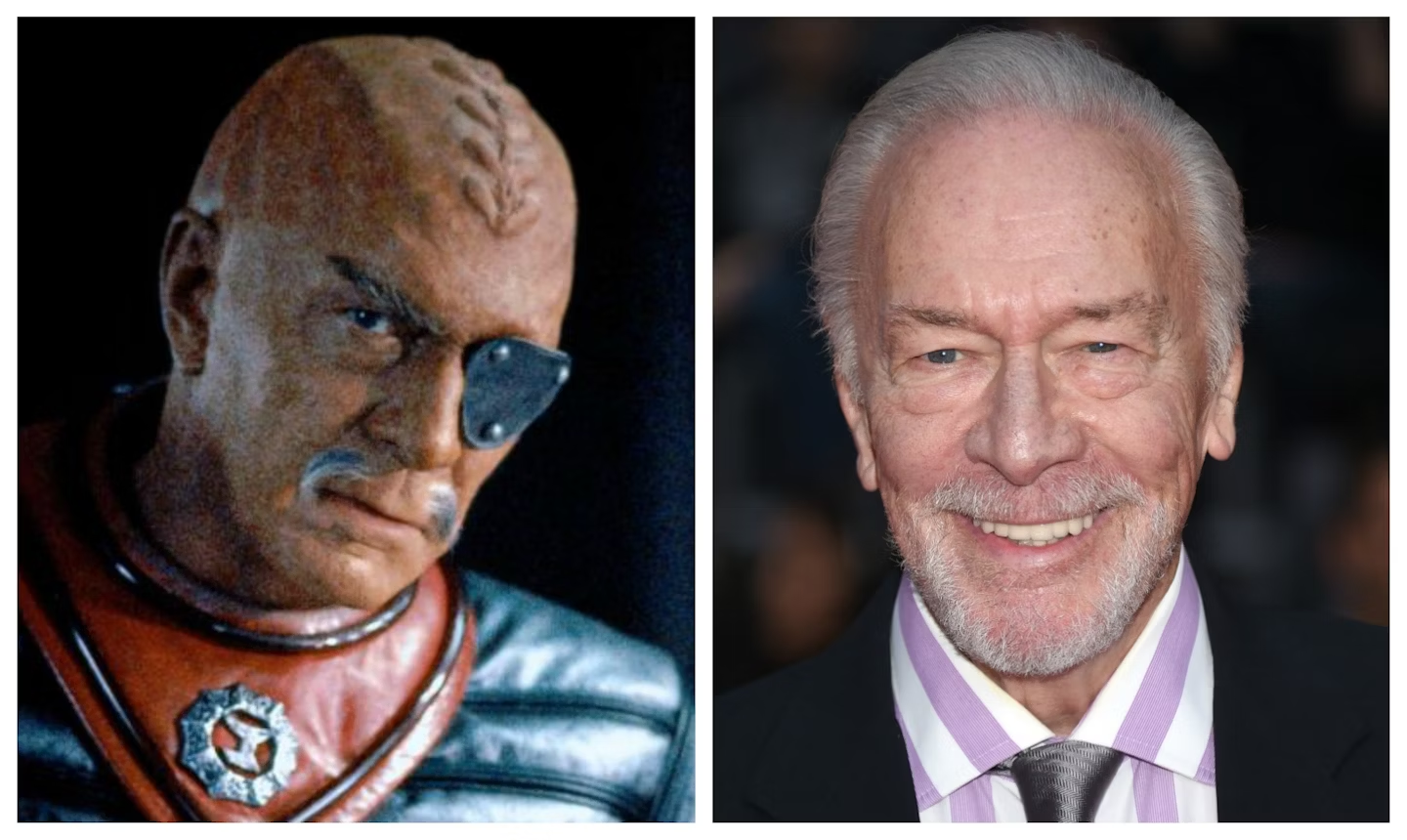
Not that we didn't already know that Canadian-born Christopher Plummer could perform Shakespeare, but that point was really driven home in 1991's Star Trek VI: The Undiscovered Country , for which he portrayed Klingon general Chang and which should have provided the Bard co-writing credit, given the number of quotes utilised. Born in 1929, Plummer's extensive film credits (not to mention his acclaimed stage work) includes The Sound Of Music , Battle Of Britain , Waterloo, Inside Man , Up , The Imaginarium Of Doctor Parnassus and The Girl With The Dragon Tattoo .
Kim Cattrall

Admittedly it wasn't Sex In The Starship , but the Liverpool-born Kim Cattrall definitely brought a lot of sexual energy to her role as the Vulcan Valeris in Star Trek VI , serving as part of a conspiracy to destroy a newly brokered peace between the Federation and the Klingon Empire. Born in 1956, her film career began in 1975 with Rosebud and went on to include such efforts as Ticket To Heaven, Porky's , Police Academy , Big Trouble In Little China , and Midnight Crossing . She is, of course, most famous for portraying Samantha Jones in the TV series Sex And The City and the two feature films spun off from it.
Head to Empire's 10 Essential Star Trek Articles
Screen Rant
10 star trek actors who played younger characters.
Star Trek has several iconic characters but the actors who play them are sometimes deceptively older than their Starfleet counterparts.
- Star Trek actors are often older than their characters due to intricate timelines and makeup effects.
- Characters like Spock have longer lifespans, allowing actors to play them at any age.
- Despite age differences, the franchise consistently casts actors who perfectly suit their roles.
Many iconic Star Trek actors are deceptively older than the iconic characters they play. Because of Stardates and complicated timelines, the age of some Star Trek characters remains unknown. However, some characters' birth years have been said on screen, and Star Trek fans have determined the birthdays of others by referencing tie-in materials or events on the Star Trek timeline. While audiences may expect actors to be about the same age as their characters, this is not always possible, especially when dealing with reboots, prequels, and spin-offs.
Many actors also look younger than they actually are, making it easy for them to pass as younger characters. Plus, in the far future of Star Trek , advances in medicine and science enable people to live longer, which makes the actors' ages largely irrelevant. Some aliens, like Vulcans, for example, have very long lives and continue to look relatively young by human standards. Regardless of the discrepancies between a character's and actor's ages, the Star Trek franchise has done a consistently good job of casting actors who perfectly suit their roles. Here are 10 Star Trek actors who are actually older than their characters.
14 Biggest Star Trek Updates: Section 31, Starfleet Academy, Strange New Worlds & More
10 deforest kelley as dr. leonard mccoy, star trek: the original series.
Born in the year 2227, Dr. Leonard McCoy went to medical school and joined Starfleet as a medical officer without attending Starfleet Academy. Although McCoy's exact Star Trek timeline is somewhat difficult to pin down, he was serving as the USS Enterprise's Chief Medical Officer by 2266, at the age of 39. DeForest Kelley was 46 in 1966 when he took on the role of Dr. McCoy in Star Trek: The Original Series , making him seven years older than his character.
In the alternate Kelvin timeline of J.J. Abrams' Star Trek films, Leonard McCoy (Karl Urban) enrolled at Starfleet Academy in 2255, soon after which he and James Kirk (Chris Pine) became close friends.
Star Trek VI: The Undiscovered Country, the final film with the entire Star Trek: The Original Series' main cast, took place in 2293, making McCoy 66 years old, while Kelley was 71. As seen in the premiere episode of Star Trek: The Next Generation , McCoy lived to be at least 137. Tragically, Deforest Kelley was the first main TOS cast member to pass away in 1999 at the age of 79, after a battle with cancer.
9 Walter Koenig As Pavel Chekov
The youngest member of Captain James T. Kirk's (William Shatner) crew, Ensign Pavel Chekov joined the Starshop Enterprise straight out of the Starfleet Academy, sometime prior to 2267. Chekov was only 22 years old at the time, and he primarily served as the ship's navigator, though Chekov would go on to fill many jobs throughout his Starfleet career. In 2293, at the age of 48, Chekov was one of the guests of honor on the maiden voyage of the USS Enterprise-B in Star Trek Generations .
Walter Koenig was already 30 when he began playing the young ensign, and he was once told he was too old to play Chekov . After joining the cast of TOS for the show's second season, Koenig went on to appear in thirty-six episodes of the series, as well as seven feature films. Born in 1936, Koenig is currently 87 and remains active in the Star Trek community, attending conventions and other events.
8 Jonathan Frakes As Commander/Captain William T. Riker
Star trek: the next generation.
Commander William Riker was born in August of 2335, making him 29 when he took on the role of First Officer on the newly launched USS Enterprise-D. Over the next several years, Riker would turn down multiple promotions to remain on the Enterprise with Captain Jean-Luc Picard (Patrick Stewart). Riker finally accepted his own command in 2379 at the age of 44, becoming Captain of the USS Titan.
Jonathan Frakes was 35 when Star Trek: The Next Generation began in 1987, making him about 6 years older than Riker. While filming Star Trek: Nemesis , Frakes was 50 compared to his character's 44. Now 71, Frakes recently reprised the role of Captain Riker for Star Trek: Picard , playing a major role in the show's award-winning third season, during which Riker was 66.
In addition to portraying William Riker (and his transporter twin Thomas Riker), Frakes has also become one of Star Trek's most beloved and prolific directors.
10 Best Star Trek Episodes Directed By Jonathan Frakes
7 avery brooks as commander/captain benjamin sisko, star trek: deep space nine.
Born in 2332, Commander Benjamin Sisko took over command of space station Deep Space Nine in 2369 when he was 37 years old. During his time on the station, Sisko was promoted to Captain, and he commanded the USS Defiant in multiple battles against the Jam'Hader and Cardassiasn during the Dominion War. In 2375, at the age of 43, Sisko sacrificed himself to end the Dominion War.
Although Sisko was initially presumed dead, the Bajoran Prophets had actually transported him to the Celestial Temple due to Sisko's status as their Emissary . Avery Books was an accomplished Shakespearean actor before he began playing Sisko in 1992 when he was 44, seven years older than his character. Brooks played Sisko for seven years on DS9 and continued to appear at Star Trek conventions for years after.
6 Roxanne Dawson As Lt. B'Elanna Torres
Star trek: voyager.
B'Elanna Torres was born in 2346 to a human father and a Klingon mother. Although she entered Starfleet Academy around the age of 18, she dropped out after two years and joined the rebel Maquis. In 2371, B'Elanna was on the Maquis ship, the Val Jean, when it was transported to the Delta Quadrant along with the USS Voyager. After the Maquis members were integrated into Voyager's crew, the 25-year-old B'Elanna became the ship's Chief Engineer, a position she held until Voyager made it home in 2378.
Actress and director Roxann Dawson was born in 1958, making her 37 when Star Trek: Voyager premiered in 1995. Despite being twelve years older than her character, Dawson has always looked younger than her actual age. Plus, the prosthetics and make-up required to make her appear half-Klingon made her age difficult to determine.
5 Scott Bakula As Captain Jonathan Archer
Star trek: enterprise.
In 2151, Jonathan Archer became the Captain of United Earth's first starship, the Enterprise NX-01. Archer had been born in 2112 in upstate New York and worked as a test pilot in the NX Program before he was chosen to take over command of the Enterprise. Archer was 39 when he set out on his first mission and 49 when his command ended in 2161 , soon after which he signed the charter ratifying the Coalition of Planets, the precursor to the Federation.
Scott Bakula was 47 when Star Trek: Enterprise began in 2001 and 51 when the show ended four seasons later. While Bakula will always be Captain Jonathan Archer for some, the actor had already achieved fame by starring as Dr. Sam Beckett in Quantum Leap from 1989 to 1993. Bakula went on to have another starring role, as Special Agent Dwayne Pride in NCIS: New Orleans , which came to an end in 2021 after seven seasons.
4 Mary Wiseman As Lt. Sylvia Tilly
Star trek: discovery.
Born on Earth in 2233, Sylvia Tilly joined the crew of the USS Discovery as an incredibly intelligent and eager Starfleet cadet sometime around the year 2256, when she was 23. In 2257, at the age of 24, Tilly was awarded the Starfleet Medal of Honor for her role in the Federation-Klingon War, at which time she also became a full ensign and joined the command track.
At the end of Star Trek: Discovery season 2 , the titular ship traveled over 900 years into the future to the 32nd century, making the characters' ages a bit more difficult to track. Tilly should be around 25 by the year 3190 when Starfleet Academy reopened and United Earth rejoined the Federation. Actress Mary Wiseman was 32 when Discovery began in 2017, and her infectious energy makes it difficult to imagine anyone else as Tilly.
Star Trek: Discovery's Wilson Cruz, Mary Wiseman & Blu del Barrio On Their Season 5 Journeys
3 ethan peck as lt. spock, star trek: discovery, star trek: strange new worlds, star trek: strange new worlds.
Being half-Vulcan, Spock had a longer lifespan than a human and lived to the age of 161. Born in 2230 to Vulcan Ambassador Sarek (James Frain) and human mother Amanda Grayson (Mia Kirshner), Spock entered Starfleet Academy sometime prior to 2250. Spock was assigned to Captain Pike's Enterprise crew in 2253, at the age of 23, although he took a leave of absence from Starfleet in 2257 after the Federation-Klingon War.
In 2258, now 28 years old, Spock returned to his position as Science Officer on the Enterprise and remains in that position as of 2259. Actor Ethan Peck was 33 when he began playing Spock in 2019, making him 38 as of 2024, while Spock remains just shy of 30. Based on the first looks at Strange New Worlds season 3 , Spock will be spending some time in a new lab set on the Starship Enterprise.
2 Christina Chong As Lt. La'an Noonien-Singh
A descendant of the infamous Earth dictator, Khan Noonien-Singh (Ricardo Montalban), La'an was born in 2228 and spent much of her childhood on the colony ship SS Puget Sound. La'an later chose to attend Starfleet Academy and graduated at the top of her class. In 2259, at the age of 31, La'an joined the crew of the USS Enterprise under the Commander of Captain Christopher Pike (Anson Mount).
The events of the Strange New Worlds season 2 finale , "Hegemony," occurred later in the year 2259, meaning La'an will still be around the age of 31 or 32 when the show returns for its third season. Actress and singer Christina Chong was 39 when Star Trek: Strange New Worlds began in 2022, making her eight years older than her character. However, like many of the actors on this list, Chong easily passes for someone in their early 30s.
1 Paul Wesley As Lt. James T. Kirk
The legendary James T. Kirk was born in 2233 in Riverside, Iowa. Kirk entered Starfleet Academy in 2252, at the age of 19, and quickly made a name for himself, becoming the only cadet in history to beat the infamous Kobayashi Maru scenario. After graduating from the Academy, Kirk joined the crew of the USS Farragut and soon became the youngest First Officer in Starfleet, at 26.
Paul Wesley made his first appearance as an alternate future James Kirk in the Strange New Worlds season 1 finale, before portraying the Prime Universe Kirk in the show's second season. Paul Wesley was 40 when he began playing Kirk in 2022, but regardless of his age, he brings the right kind of charming energy to the role and has the look of a young Jim Kirk. It remains to be seen how large of a role Wesley's James Kirk will play in Strange New Worlds season 3, which will hopefully be one of the first Star Trek projects to premiere in 2025.
All of these Star Trek shows are streaming on Paramount+.
/cdn.vox-cdn.com/uploads/chorus_image/image/73236408/22373_STDC_S5_Official_Trailer_PR_Vert_2700x4000.0.jpg)
Filed under:
- 2024 Spring Entertainment Preview
Star Trek: Discovery is finally free to do whatever it wants
Imagining the future of the future
Share this story
- Share this on Facebook
- Share this on Reddit
- Share All sharing options
Share All sharing options for: Star Trek: Discovery is finally free to do whatever it wants
It’s a truth universally acknowledged that even among the greatest television shows in Star Trek history, most of them take two seasons to stop being kind of bad. Never has that been more true or more excruciating than in the case of Star Trek: Discovery .

Polygon is looking ahead to the movies, shows, and books coming soon in our Spring 2024 entertainment preview package, a weeklong special issue.
Often it felt like what Discovery was really doing in its early seasons was discovering what didn’t work. Strong performances from a great cast? That works. A Klingon design that absolutely nobody liked ? Definitely not. But despite the stumbles, Discovery season 1 had still averaged C’s and B’s with reviewers, and had built an audience and a subscriber base for Paramount Plus. On the strength of Disco ’s first season, Paramount greenlit Star Treks Picard , Lower Decks , and Prodigy , three new shows covering a huge range of ages and nostalgic tastes. And spinning out of Disco ’s second season, which introduced familiar , nostalgic characters and a brighter, more Star Trek-y tone, Paramount produced Star Trek: Strange New Worlds , inarguably the best new addition to the franchise since 1996.
Star Trek: Discovery crawled so that the rest of modern Trek could run... and then it started to walk. The show’s third season saw the USS Discovery and crew in the place that should have been their starting blocks: the bleeding future edge of Star Trek’s timeline. Thanks to season 3’s groundwork, season 4 became the first time that Discovery had a status quo worth returning to. In its fifth and final season, Star Trek: Discovery is finally free — free in a way that a Star Trek TV series hasn’t been in 23 years.
:no_upscale()/cdn.vox-cdn.com/uploads/chorus_asset/file/25348410/DISCO_501_MGG_0624_1015_RT.jpeg)
Star Trek: The Next Generation is such an elder statesman of the television elite that it’s easy to forget that it was daring. The show’s triumph wasn’t just that it featured a new cast of characters, but also its audaciousness in imagining the future of the future — and making that future unmistakably different . The Original Series showed a racial and national cooperation that seemed fantastical in its time, with an alien crewmember to denote the next frontier of embracing the other . Next Generation saw that bet and raised it, installing a member of the Klingon species, the Federation’s once-feared imperialist rival state, as a respected officer on the bridge of Starfleet’s flagship.
Next Generation ’s time period — one century after Kirk’s Enterprise — wasn’t a nominal choice, but a commitment to moving the story of Star Trek forward. From the show’s foundations, Gene Roddenberry and his collaborators, new and old, set a precedent that the Federation would evolve. Therefore, in accordance with the utopian themes of the franchise, old enemies would in time become friends. Next Generation embraced The Original Series ’ nemeses and the rest of ’90s Trek saw that bet and raised it again, pulling many of Next Gen ’s villains into the heroic fold. Voyager welcomed a Borg crewmember and disincorporated the Borg empire; Deep Space Nine gave the franchise the first Ferengi Starfleet cadet, and brokered a Federation-Klingon-Romulan alliance in the face of an existential threat.
But Discovery — at least until it made its Olympic long-jump leap 900 years into the future — couldn’t move Star Trek forward. So long as it was set “immediately before Kirk’s Enterprise,” hemmed in by the constraints of a previously established era of Star Trek history, it could graft on new elements (like Spock’s secret human foster sister) but it couldn’t create from whole cloth (like a galaxy-wide shortage of starship fuel that nearly destroyed the Federation). Like its predecessor, the ill-fated Star Trek: Enterprise of the ’00s, it was doomed to hang like a remora on the side of the events of The Original Series , or, if you’ll pardon another fish metaphor, doomed like a goldfish that can only grow as large as its half-gallon fishbowl will allow.
Discovery ’s later, free seasons in the 32nd century have shown the Federation at its most vulnerable, a subtler echo of Picard ’s own season 1 swing at fallen institutions . (Fans of Voyager and Deep Space Nine know that this is an extremely rich vein of Trek storytelling.) In its third season, Discovery solved a galaxy-wide fuel crisis that had shattered the community of the Federation. In its fourth it fought for a fragile new Federation alliance and its millennia-old ideals.
And those seasons have also boldly committed to the idea of imagining the future’s future — 900 years of it. The centuries-old rift between Vulcans and Romulans is long healed, Ferengi serve as captains in Starfleet, the work of Doctor Noonien Soong has brought new medical technologies to the fore.
Even still, Discovery hasn’t been truly free in its third and fourth seasons. Star Trek: Picard was out there, forming new past elements of a post- Next Gen / Voy / DS9 era that Discovery had to abide by. And, after all, the show still had to make sure there was something for its own next season to come back to.
:no_upscale()/cdn.vox-cdn.com/uploads/chorus_asset/file/25348428/DISCO_503_JM_0803_0191_1_RT.jpeg)
But now — with Prodigy and Picard finished, and Strange New Worlds and Lower Decks locked into their settings of Star Trek’s established past, and Starfleet Academy and Section 31 not yet in production at the time that its final season would have been written — Discovery has reached the final final frontier for a Star Trek show. If you’re a Star Trek fan, that should excite you.
Not since Deep Space Nine in 1999 and Voyager in 2001 has a Star Trek series had the freedom to wrap up its run with the Federation in any state it wants to. With franchise flagship Next Generation at an end, and Voyager restricted to the Delta Quadrant only, Deep Space Nine used its last seasons to throw the Federation into all-out war, making sweeping changes to the established ficto-political norms of ’90s Trek. Voyager used its finale to do what Captain Picard never could: defang the Borg (mostly).
We don’t know exactly what Discovery will do with that freedom. Season 4 directors have talked about reaching “ into the past to get further into the future ,” and likened it to Indiana Jones. Official news releases have said the crew will “uncover a mystery that sends them on an epic adventure across the galaxy to find an ancient power whose very existence has been deliberately hidden for centuries.” But speculating on what that means would be beside the point.
Discovery , the show about an intergalactically teleporting starship, can finally, actually, go anywhere. It’s been almost a quarter of a century since a beloved Star Trek series was so free to boldly go. Let’s hope they’re very bold indeed.
Star Trek: Discovery season 5 premieres with two episodes on April 4 on Paramount Plus.
Spring 2024 entertainment preview
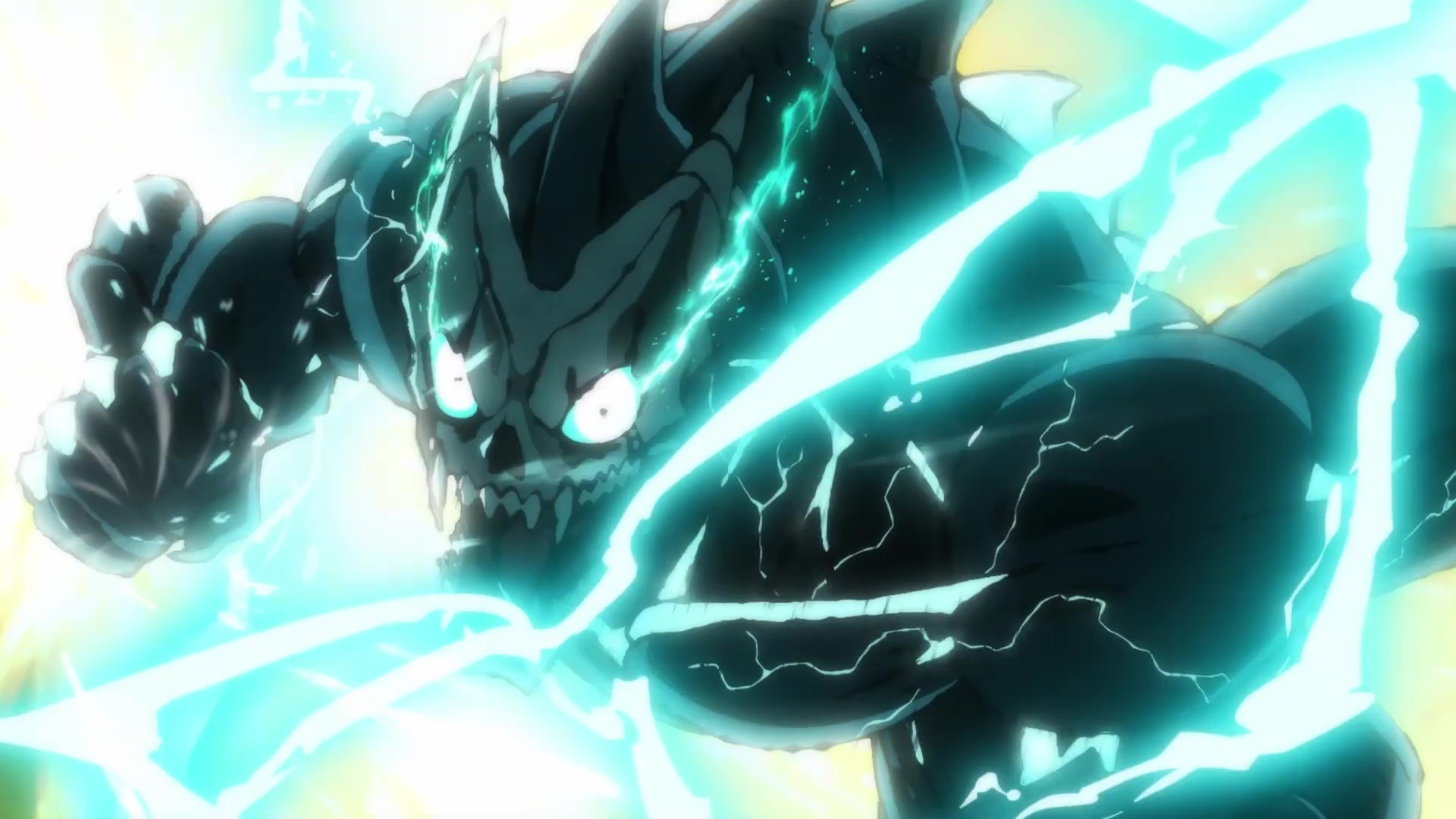
Loading comments...
This Obscure 'Next Generation' Character Will Return in 'Star Trek: Section 31'
Michelle Yeoh's Philippa Georgiou will meet an interesting familiar face.
The Big Picture
- Paramount+ reveals cast member Kacey Rohl will play Rachel Garrett in the upcoming Star Trek: Section 31 movie.
- Originally planned as a series, the film follows Michelle Yeoh's Philippa Georgiou in her work for Section 31.
- Rachel Garrett captained the USS Enterprise-C in the classic Star Trek: The Next Generation episode "Yesterday's Enterprise."
Details on Paramount+'s upcoming Star Trek: Section 31 movie have so far been as top-secret as its namesake Starfleet spy agency. But now we know one of the characters who will encounter Michelle Yeoh 's Philippa Georgiou - and she's an important part of Star Trek history. A new feature in Variety goes behind the scenes of the filming of the streaming-original film, which recently wrapped filming , and reveals that previously-announced cast member Kacey Rohl ( Hannibal ) will be playing Rachel Garrett, a character who captained the USS Enterprise-C in the classic Star Trek: The Next Generation episode "Yesterday's Enterprise".
Little else is known about the upcoming film; it was originally planned as a series, but with Yeoh's busy schedule following her groundbreaking Best Actress Oscar win for Everything Everywhere All At Once , it was compressed into a single standalone film. It will follow Georgiou's work for the shadowy Starfleet intelligence agency Section 31, following her return to the 23rd century in the third season of Star Trek: Discovery . In addition to Yeoh and Rohl, it will also star Omari Hardwick , Sam Richardson , Sven Ruygrok , Rob Kazinsky , Humberly Gonzalez , James Hiroyuki Liao , Joe Pingue , Miku Martineau , and Augusto Bitter .
Who is Rachel Garrett?
In "Yesterday's Enterprise", which aired in 1990 as part of The Next Generation 's third season, the 24th-century Enterprise-D finds itself confronted with its long-thought-destroyed predecessor, the Enterprise-C , captained by Rachel Garrett ( Tricia O'Neil ). Somehow, the Enterprise-C being thrown into the future has altered the future; instead of the relatively peaceful galaxy familiar to the show's viewers, the Federation is embroiled in a desperate war with the Klingon Empire . The crew soon realizes that the Enterprise-C must respond to a Klingon distress call in its own timeline, even though it means the ship will be destroyed by the Romulans ; Garrett is soon killed in an ambush by the future Klingons, forcing helmsman Richard Castillo ( Christopher McDonald ) to take over the ship with Enterprise-D security officer Tasha Yar ( Denise Crosby ), leading it to its fate in the past. Ultimately, the Enterprise-C 's sacrifice averts war with the Klingons and restores the Enterprise-D 's future to its rightful state, while Garrett and her crew are remembered as heroes. However, the Enterprise-C 's legacy later came back to haunt the Enterprise-D ; Yar survived and bore a half-Romulan daughter, Sela, who would become one of the crew's recurring foes.
"Yesterday's Enterprise" is considered to be one of The Next Generation 's finest episodes. Collider's Liam Gaughan deemed it to be the best episode of season 3 , calling it a "fascinating look at a darker version of the setting we know and love" while also serving as a proper sendoff for Tasha Yar, who had been unceremoniously killed off in the show's first season.
Star Trek: Section 31 is now in post-production, and has not yet set a release date . Stay tuned to Collider for future updates.
Star Trek: The Next Generation
Set almost 100 years after Captain Kirk's 5-year mission, a new generation of Starfleet officers sets off in the U.S.S. Enterprise-D on its own mission to go where no one has gone before.
Noah Wyle to Star in Max Medical Procedural ‘The Pitt’ From ‘ER’ Alums John Wells, R. Scott Gemmill
By Joe Otterson
Joe Otterson
TV Reporter
- Netflix Medical Procedural ‘Pulse’ Adds Five to Cast 1 day ago
- Claire Danes, ‘Homeland’ Co-Creator Howard Gordon Team for Netflix Limited Series ‘Beast in Me’ 1 day ago
- John Leguizamo Joins Taron Egerton in Apple Drama Series ‘Firebug,’ Kari Skogland to Direct 2 days ago

Noah Wyle is going back to his roots, with the actor set to star in a medical procedural series that has been ordered at Max .
Variety has learned that Max has given a 15-episode order to the series, currently titled “The Pitt.” Wyle will star and executive produce the show, which is described as “a realistic examination of the challenges facing healthcare workers in today’s America as seen through the lens of the frontline heroes working in a modern-day hospital in Pittsburgh,” per the official logline.
“We are grateful to Warner Bros. Television and Max for giving us this opportunity to return to the world of urban medicine,” Wyle, Wells, and Gemmill said in a joint statement. “The myriad of challenges facing the doctors, nurses, technicians, patients, and their families who work in the trenches of modern medicine have become only more pronounced in the decade and a half since we last visited their stories. We’re thrilled to be able to return to this world with the support of our partners and are looking forward to pushing the boundaries of dramatic realism and medical accuracy in following the lives of these heroic men and women.”
Gemmill penned the first episode of the series and serves as executive producer and showrunner. Wells executive produces along with Erin Jontow via John Wells Productions. In addition to Wyle, other executive producers include Simran Baidwan and Michael Hissrich. Warner Bros Television, where John Wells Productions is under an overall deal, will serve as the studio.
“ER” aired for 15 seasons on NBC and was one of the most popular show’s on television during its run. It won nearly two dozen Emmys in that time with over 100 nominations. Wyle received five consecutive Emmy nominations for the show from 1995-1999 for best supporting actor in a drama as well as three Golden Globe nominations.
“It’s no secret Scott, Noah, and John know how to make great television,” said Channing Dungey, Warner Bros. Television Group Chairman and CEO. “When they came to us with the idea of reinvigorating the medical TV genre with a fresh, realistic look at today’s modern hospitals, we knew we had to jump on it. Their all-star collaboration, along with their impeccable storytelling and unwavering passion they bring to every project, is the perfect prescription for this show to become the next great medical drama. We are thankful to our partners at Max, and we can’t wait for audiences to see this show.”
In addition to his time on “ER,” Wyle is known for leading “The Librarian” franchise that includes three made-for-TV movies as well as the TV series of the same name. He also starred in the post-apocalyptic alien invasion drama “Falling Skies” at TNT and currently stars in “Leverage: Redemption” for Amazon Prime Video. In film, Wyle has been in features such as “A Few Good Men,” “Donnie Darko,” and “White Oleander.”
He is repped by Verve, Brillstein, and Jackoway Austen Tyerman.
This marks the latest medical procedural to get picked up at a streamer. Netflix recently announced a series order for “Pulse,” which is set in a Miami hospital. Procedurals ranked among the top primetime telecasts of 2023 and are consistently among the most-watched shows on streaming in the Nielsen rankings. Procedurals are also typically cheaper to produce than more serialized, prestige dramas at a time when all networks and streamers are looking to cut costs. In addition, they can sustain incredibly long runs, with “Law & Order: SVU” currently in its 25th season at NBC and “Grey’s Anatomy” entering its 20th season at ABC.
More From Our Brands
South carolina vs. indiana livestream: how to watch the march madness women’s game online, the ‘world’s best single malt whisky’ was just crowned and it isn’t from scotland, a-rod, lore say they’re ‘going to be’ the next timberwolves owners, the best loofahs and body scrubbers, according to dermatologists, orphan black: echoes, starring krysten ritter, sets june premiere date — watch teaser trailer, verify it's you, please log in.
Star Trek: The Motion Picture (1979)
Full cast & crew.

Directed by
Writing credits , cast (in credits order) verified as complete , produced by , music by , cinematography by , editing by , casting by , production design by , art direction by , set decoration by , costume design by , makeup department , production management , second unit director or assistant director , art department , sound department , special effects by , visual effects by , stunts , camera and electrical department , costume and wardrobe department , editorial department , music department , script and continuity department , transportation department , additional crew , thanks .
Release Dates | Official Sites | Company Credits | Filming & Production | Technical Specs
Contribute to This Page
- Full Cast and Crew
- Release Dates
- Official Sites
- Company Credits
- Filming & Production
- Technical Specs
- Plot Summary
- Plot Keywords
- Parents Guide
Did You Know?
- Crazy Credits
- Alternate Versions
- Connections
- Soundtracks
Photo & Video
- Photo Gallery
- Trailers and Videos
- User Reviews
- User Ratings
- External Reviews
- Metacritic Reviews
Related Items
- External Sites
Related lists from IMDb users

Recently Viewed

IMAGES
COMMENTS
Star Trek: Deep Space Nine: Created by Rick Berman, Michael Piller. With Avery Brooks, Rene Auberjonois, Cirroc Lofton, Alexander Siddig. In the vicinity of the liberated planet of Bajor, the Federation space station Deep Space Nine guards the opening of a stable wormhole to the far side of the galaxy.
Roger Holloway as Roger Lemli, security officer. Eddie Paskey as Leslie, various positions. David L. Ross as Galloway, various positions. Jim Goodwin as John Farrell, navigator. Grant Woods as Kelowitz, science officer. William Blackburn as Hadley, helmsman. Frank da Vinci as Brent, various positions.
Star Trek: Deep Space Nine (TV Series 1993-1999) cast and crew credits, including actors, actresses, directors, writers and more. Menu. ... (based upon "Star Trek" created by) (173 episodes, 1993-1999) Robert Hewitt Wolfe ... (executive story editor) (26 episodes, 1994-1995) Robert Hewitt Wolfe ...
Star Trek: Deep Space Nine (DS9) is an American science fiction television series created by Rick Berman and Michael Piller.The fourth series in the Star Trek media franchise, it originally aired in syndication from January 3, 1993, to June 2, 1999, spanning 176 episodes over seven seasons. Set in the 24th century, when Earth is part of a United Federation of Planets, its narrative is centered ...
Star Trek: Deep Space Nine was the fourth Star Trek series and entered production in 1992. It was broadcast in first-run syndication from January 1993 until June 1999. It was the first Star Trek series created by Rick Berman and Michael Piller rather than by Gene Roddenberry. It was also the only series to air alongside another Star Trek production throughout its entire run, airing alongside ...
Star Trek made celebrities of its cast of largely unknown actors. Kelley had appeared in many films and television shows, but mostly in smaller roles that showcased him as a villain. ... The 1999 film Galaxy Quest portrays the lives of a once-popular television space-drama crew who are kidnapped by real aliens who have mistaken the fictional ...
Learn more about the full cast of Star Trek: Deep Space Nine with news, photos, videos and more at TV Guide. X ... 168 Episodes 1999. Corey Allen. 167 Episodes 1999. David Livingston. 17 Episodes ...
Nichelle Nichols, who played Nyota Uhura, died in July 2022. "Star Trek" debuted 56 years ago on September 8, 1966. After the show, the cast of the original series remained sci-fi icons. Only ...
Star Trek: Deep Space Nine chronicles the adventures of Captain Benjamin Sisko and a team of Starfleet officers who take command of a remote space station on the edge of a frontier and a critical crossroads of galactic events. 7 seasons • 176 episodes • 1993-1999
As Star Trek Discovery prepares to introduce a new Spock, Empire revisits the original series' cast. ... The Cast Of Star Trek: Then And Now. by Ed Gross | Published on 08 06 2016. ... 1999. James ...
Star Trek (TV Series 1966-1969) cast and crew credits, including actors, actresses, directors, writers and more. Menu. Movies. Release Calendar Top 250 Movies Most Popular Movies Browse Movies by Genre Top Box Office Showtimes & Tickets Movie News India Movie Spotlight. TV Shows.
Star Trek: The Original Series - originally known simply as Star Trek - features some of the most iconic characters in all of science fiction with the crew of the original USS Enterprise. After its initial pilot episode was rejected by network NBC, Star Trek was massively overhauled with a largely new cast and a more adventurous tone.Star Trek debuted in 1966, and while it was never a ratings ...
Introduction List of Star Trek characters List of Star Trek characters; Key; Main and recurring characters; Appearances Star Trek: The Original Series Star Trek: The Next Generation Star Trek: Deep Space Nine Star Trek: Voyager Star Trek: Enterprise Star Trek: Discovery Star Trek: Picard Star Trek: Lower Decks Star Trek: Prodigy Star Trek: Strange New Worlds; Shared cast
1993-1999: TV GEN: Star Trek Generations: 1994: film VOY: Star Trek: Voyager: 1995-2001: TV FC: Star Trek: First Contact: 1996: film INS: Star Trek: Insurrection: 1998: film NEM: ... Shared cast. Star Trek has an ongoing tradition of actors returning to reprise their roles in other spin-off series. In some instances, actors have portrayed ...
Star Trek VI: The Undiscovered Country, the final film with the entire Star Trek: The Original Series' main cast, took place in 2293, making McCoy 66 years old, while Kelley was 71.As seen in the premiere episode of Star Trek: The Next Generation, McCoy lived to be at least 137. Tragically, Deforest Kelley was the first main TOS cast member to pass away in 1999 at the age of 79, after a battle ...
Star Trek: Created by Gene Roddenberry. With Leonard Nimoy, William Shatner, DeForest Kelley, Nichelle Nichols. In the 23rd Century, Captain James T. Kirk and the crew of the U.S.S. Enterprise explore the galaxy and defend the United Federation of Planets.
Star Trek: The Magazine (1999-2003) Films and television; Film(s) The Original Series. The Motion Picture (1979) II: The Wrath of Khan (1982) ... named after the fictional starship with Star Trek television cast members and creator Gene Roddenberry in 1976 ISS-42 astronaut Samantha Cristoforetti pays tribute to actor Leonard Nimoy, ...
Star Trek: The Next Generation is such an elder statesman of the television elite that it's easy to forget that it was daring. The show's triumph wasn't just that it featured a new cast of ...
Paramount+ reveals cast member Kacey Rohl will play Rachel Garrett in the upcoming Star Trek: Section 31 movie. Originally planned as a series, the film follows Michelle Yeoh's Philippa Georgiou ...
Justin Stafford. ... special contact lens painter. Susan Stepanian. ... makeup artist. Miho Suzuki. ... makeup effects lab technician: Proteus Make-up FX.
The Original Series logo. Star Trek is an American media franchise based on the science fiction television series created by Gene Roddenberry.The first television series, simply called Star Trek and now referred to as The Original Series, debuted in 1966 and aired for three seasons on NBC.The Star Trek canon includes eight live-action television series, three animated series and one short-form ...
Noah Wyle to Star in Max Medical Procedural 'The Pitt' From 'ER' Alums John Wells, R. Scott Gemmill. Noah Wyle is going back to his roots, with the actor set to star in a medical ...
composer: theme "Star Trek" Jerry Goldsmith ... conductor (uncredited) Kenneth Hall ... music editor (as Ken Hall) Craig Huxley ... composer: additional music, Blaster Beam, microtonal clavichord, Tubulons, Serge Modular System, piano Francesco Lupica ... additional score sound design Arthur Morton ...